Hans Graf
Quantedge Music Director
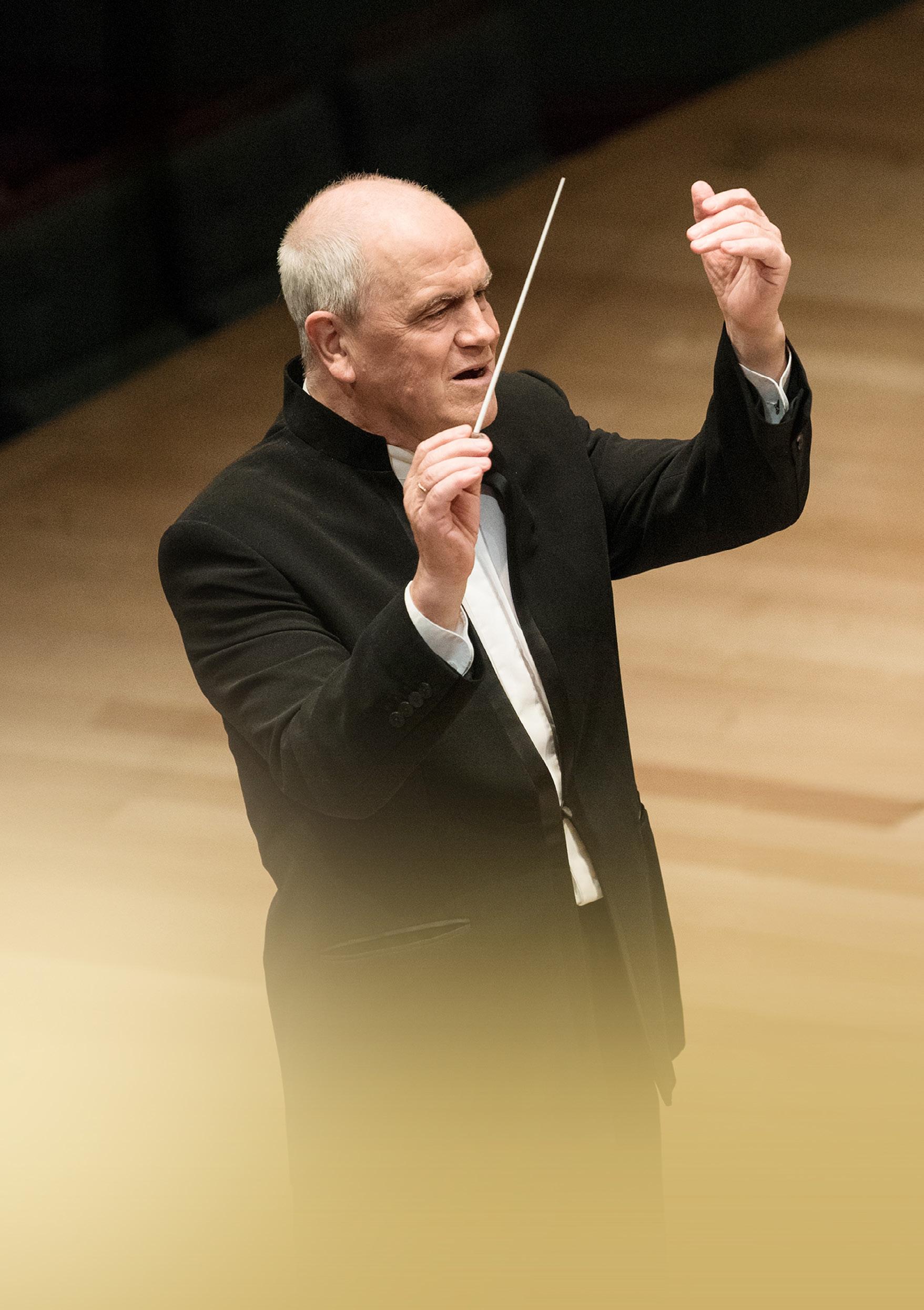

Hans Graf
Quantedge Music Director

2 & 3 May 2025
Mozart and Finzi –Rodolfo Barráez and Ma Yue
23 & 24 May 2025
Mahler’s Resurrection Symphony
ARTIST HIGHLIGHTS
Yo-Yo Ma, Julia Hagen, Chloe Chua, Leonidas Kavakos, Daniel Lozakovich, Bertrand Chamayou, Eric Lu, Sayaka Shoji, Simon Trpčeski, Yeol Eum Son and Sergei Nakariakov with conductors Han-Na Chang, Joe Hisaishi, Mikhail Pletnev, Masaaki Suzuki and Kahchun Wong.
PROGRAMME HIGHLIGHTS
An Alpine Symphony, The Planets (with a new Earth), Pictures at an Exhibition in two orchestrations, New World Symphony, Scheherazade, Saint-Saëns’s Organ Symphony, and masterpieces by Mahler, Nielsen, Shostakovich and Tchaikovsky.
FEATURING SINGAPORE'S
Ding Yi Music Company, Singapore Chinese Orchestra, Isaac Lee, Churen Li, Lin Chien-Kwan, Lien Boon Hua, Jonathan Shin and many more
Hans Graf Quantedge Music Director
Rodolfo Barráez Associate Conductor
Hannu
Music Director-Designate






For the enjoyment of all patrons during the concert:
Please switch off or silence all electronic devices.
Please minimise noises during performance. If unavoidable, wait for a loud section in the music.
Mozart and Finzi – Rodolfo Barráez and Ma Yue
Fri & Sat, 2 & 3 May 2025
Victoria Concert Hall
Mahler’s Resurrection Symphony
Fri & Sat, 23 & 24 May 2025
Esplanade Concert Hall
No photography, video or audio recording is allowed when artists are performing.
Non-flash photography is allowed only during bows and applause when no performance is taking place.
Go green. Digital programme books are available on www.sso.org.sg.
Photographs and videos will be taken at these events, in which you may appear. These may be published on the SSO’s publicity channels and materials. By attending the event, you consent to the use of these photographs and videos for the foregoing purposes.
Cover photo: Hans Graf © Jack Yam
The orchestra performs over 60 concerts a year, and its versatile repertoire spans alltime favourites and orchestral masterpieces to exciting cutting-edge premieres. Bridging the musical traditions of East and West, Singaporean and Asian musicians and composers are regularly showcased in the concert season. The SSO makes its performing home at the 1,800-seat state-of-the-art Esplanade Concert Hall. More intimate works, as well as community performances take place at the 673-seat Victoria Concert Hall, the Home of the SSO.
Since its founding in 1979, the Singapore Symphony Orchestra (SSO) has been Singapore’s flagship orchestra, touching lives through classical music and providing the heartbeat of the cultural scene with its 44week calendar of events.
In addition to its subscription series concerts, the orchestra is well-loved for its outdoor and community appearances, and its significant role educating the young people of Singapore through its school programmes. The SSO has also earned an international reputation for its orchestral virtuosity, having garnered sterling reviews for its overseas tours and many successful recordings. In 2021, the SSO clinched third place in the prestigious Orchestra of the Year Award by Gramophone. In 2022, BBC Music Magazine named the SSO as one of the 23 best orchestras in the world.
From the 2026/27 season, the SSO will be led by Finnish conductor Hannu Lintu, the fourth Music Director in the orchestra’s history after Choo Hoey (1979–1996), Lan Shui (1997–2019) and Hans Graf (2020–2026).
Beyond Singapore, the SSO has performed in Europe, Asia, Australia and the United States. In the 2024/25 season, the SSO performed to full houses at Asia Orchestra Week in Kyoto, Japan, and made its “dazzling – and true-blue – Down Under debut” (Limelight) in Sydney, Melbourne and Brisbane. In May 2016, the SSO was invited to perform at the Dresden Music Festival and the Prague Spring International Music Festival. This successful five-city tour of Germany and Prague also included the SSO’s second performance at the Berlin Philharmonie. In 2014, the SSO’s debut at the 120th BBC Proms in London received praise in major UK newspapers The Guardian and The Telegraph. The SSO has also performed in China on multiple occasions.
The SSO has released more than 50 recordings, with over 30 on the BIS label. Recent critically acclaimed albums include Herrmann’s Wuthering Heights (Chandos) and Scriabin – Poems of Ecstasy and Fire (BIS).
A complete Mozart Violin Concerto cycle with Singaporean violinist Chloe Chua conducted by Hans Graf will be released in 2025 on Pentatone. The SSO also leads the revival and recording of significant works such as Kozłowski’s Requiem, Ogerman’s Symbiosis (after Bill Evans) and violin concertos by Robert Russell Bennett and Vernon Duke.
The SSO has collaborated with such great artists as Vladimir Ashkenazy, Gustavo Dudamel, Charles Dutoit, Joe Hisaishi, Neeme Järvi, Lorin Maazel, Martha Argerich, Diana Damrau, Janine Jansen, Leonidas Kavakos, Lang Lang, Yo-Yo Ma, Mischa Maisky, Gil Shaham, Daniil Trifonov and Krystian Zimerman.
The SSO is part of the Singapore Symphony Group, which also manages the Singapore Symphony Choruses, the Singapore National Youth Orchestra, the Singapore International Piano Festival and the biennial National Piano & Violin Competition.
The Group’s vision is to be a leading arts organization that engages, inspires and reflects Singapore through musical excellence. Our mission is to create memorable shared experiences with music. Through the SSO and its affiliated performing groups, we spread the love for music, nurture talent and enrich our diverse communities.

Hans Graf
Quantedge Music Director
Rodolfo Barráez
Associate Conductor
Choo Hoey
Conductor Emeritus
Lan Shui
Conductor Laureate
Eudenice Palaruan
Choral Director
Wong Lai Foon Choirmaster
Ellissa Sayampanathan
Assistant Choral Conductor
(Position vacant) Concertmaster, GK Goh Chair
David Coucheron Co-Principal Guest Concertmaster
Kevin Lin Co-Principal Guest Concertmaster
Kong Zhao Hui1 Associate Concertmaster
Chan Yoong-Han2 Assistant Principal
Cao Can*
Duan Yu Ling
Foo Say Ming
Jin Li
Kong Xianlong
Cindy Lee
Karen Tan
William Tan
Wei Zhe
Ye Lin*
Zhang Si Jing
Nikolai Koval*
Sayuri Kuru
Hai-Won Kwok
Renyu Martin Peh^
Margit Saur
Shao Tao Tao
Wu Man Yun*
Xu Jueyi*
Yin Shu Zhan*
Zhao Tian
Manchin Zhang Principal, Tan Jiew Cheng Chair
Guan Qi Associate Principal
Gu Bing Jie* Assistant Principal
Marietta Ku
Luo Biao
Julia Park
Shui Bing
Janice Tsai
Dandan Wang
Yang Shi Li
Ng Pei-Sian Principal, The HEAD Foundation Chair
Yu Jing Associate Principal
Guo Hao Assistant Principal
Chan Wei Shing
Christopher Mui
Jamshid Saydikarimov
Song Woon Teng
Wang Yan
Wu Dai Dai
Zhao Yu Er
Yang Zheng Yi Acting Principal
Karen Yeo Assistant Principal
Jacek Mirucki
Guennadi Mouzyka
Wang Xu
Jin Ta Principal, Stephen Riady Chair
Evgueni Brokmiller Associate Principal
Roberto Alvarez
Miao Shanshan
Piccolo
Roberto Alvarez Assistant Principal
Oboe
Rachel Walker Principal
Pan Yun Associate Principal
Carolyn Hollier
Elaine Yeo
Cor Anglais
Elaine Yeo Associate Principal
Clarinet
Ma Yue Principal
Li Xin Associate Principal
Liu Yoko
Tang Xiao Ping
Bass Clarinet
Tang Xiao Ping Assistant Principal
Bassoon
Guo Siping Principal
Liu Chang Associate Principal
Christoph Wichert
Zhao Ying Xue
Contrabassoon
Zhao Ying Xue Assistant Principal
Austin Larson Principal
Gao Jian Associate Principal
Jamie Hersch Associate Principal
Marc-Antoine Robillard Associate Principal
Bryan Chong^
Hoang Van Hoc
Trumpet
Jon Paul Dante Principal
David Smith Associate Principal
Lau Wen Rong
Nuttakamon Supattranont
Allen Meek Principal
Damian Patti Associate Principal
Samuel Armstrong
Bass Trombone
Wang Wei Assistant Principal
Tomoki Natsume Principal
Christian Schiøler Principal
Mario Choo
Jonathan Fox Principal
Mark Suter Associate Principal
Mario Choo
Lim Meng Keh
Harp
Gulnara Mashurova Principal
With deep appreciation to the Rin Collection for their generous loan of string instruments. Musician on annual contract.
Kong Zhao Hui performs on a J.B. Guadagnini of Milan, c. 1750, donated by the National Arts Council, Singapore, with the support of Far East Organization and Lee Foundation.
Chan Yoong-Han performs on a David Tecchler, Fecit Roma An. D. 1700, courtesy of Mr G K Goh. Musicians listed alphabetically by family name rotate their seats on a per programme basis.
Mozart and Finzi – Rodolfo Barráez and Ma Yue
2 & 3 May 2025
First Violin
Angela Chan Guest Concertmaster
Mahler’s Resurrection Symphony
23 & 24 May 2025
First Violin
Lim Shue Churn
Wilford Goh
Yew Shan
Second Violin
Bobur Eshpulatov
Lee Shi Mei
Yvonne Lee
Ikuko Takahashi
Edward Tan
Viola
Ho Qian Hui
Thantakorn Lakanasirorat
Yeo Jan Wea
Cello
Cao Huiying
Double Bass
Beatriz Garcia Guest Principal
Olga Alexandrova
Hibiki Otomo
Second Violin
Yvonne Lee
Clarinet
Chen Wei Leng
Horn
Grzegorz Curyla
Takeshi Hidaka
Lewis Lim
Alexander Oon
Gabrielle Pho
Eric Yen
Trumpet
John Foster
Huang Shan
Jun Ikebe
Loi Chiang Kang
Percussion
Sng Yiang Shan
Julia Tan
Michael Tan
Viola Yeo Jan Wea
Harp
Charmaine Teo Guest Principal
Karen Tay
Organ
Joanna Paul

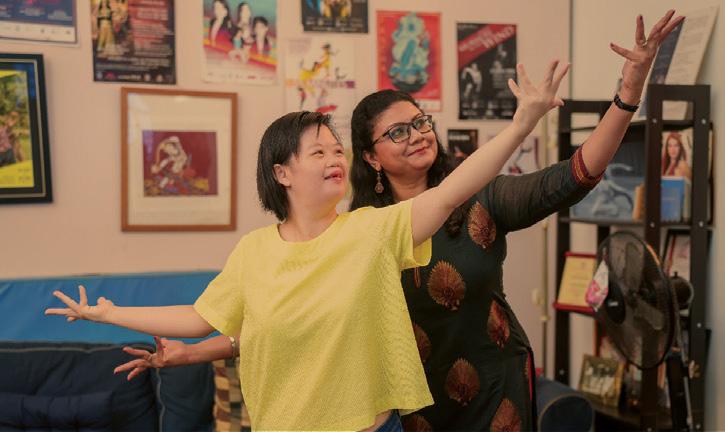

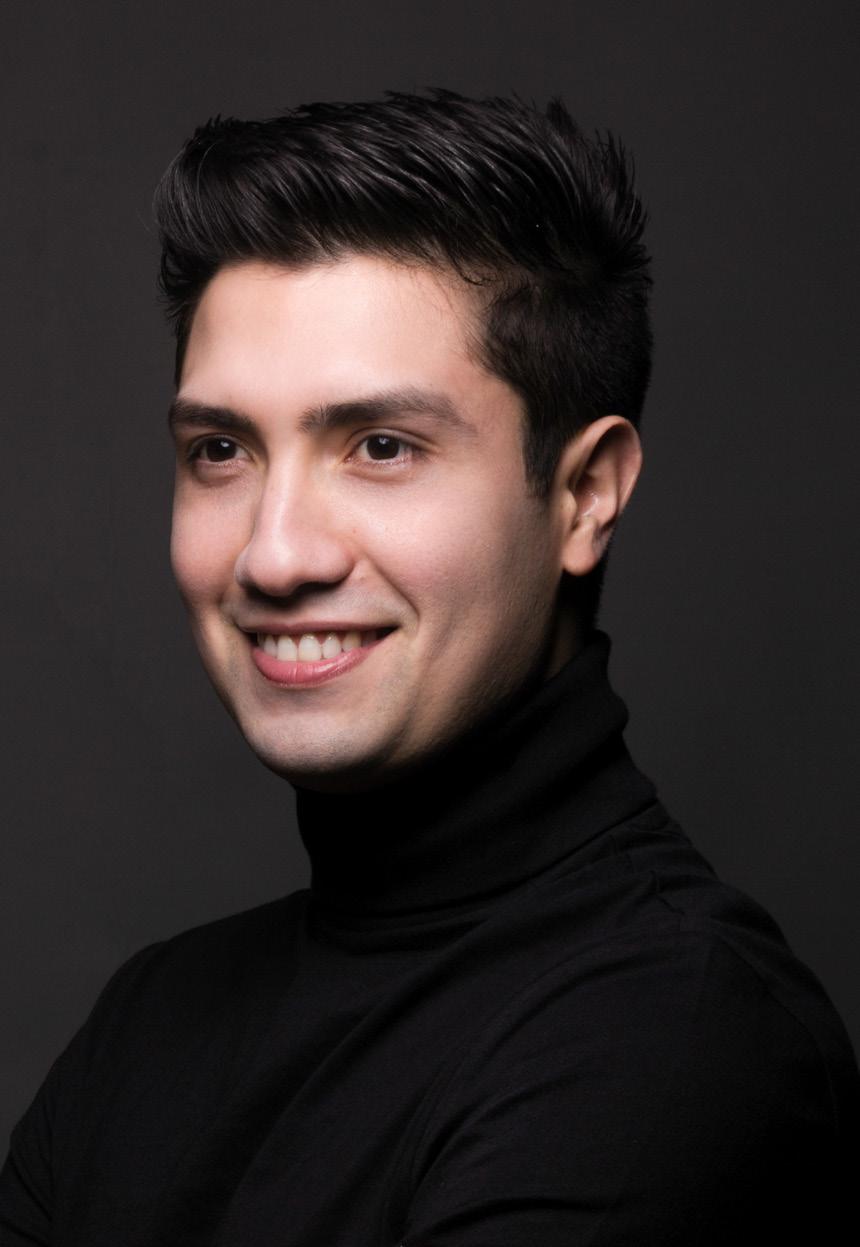
A natural communicator with infectious charisma, Berlin-based Venezuelan conductor Rodolfo Barráez brings remarkable vivacity, sensitivity, and zeal to his artistry. The 2023/24 season sees him join the Los Angeles Philharmonic Orchestra as Assistant Conductor, his appointment of Associate Conductor of the Simón Bolívar Symphony Orchestra of Venezuela, as well as begin his second season as Associate Conductor of the Singapore Symphony Orchestra. Rodolfo is also Conductor-in-Residence at the Paris Opera.
In 2023, Rodolfo was awarded first prize at the Hong Kong International Conducting Competition. He also won first prize at the 2018 Universidad Nacional Autónoma de México International Conducting Competition (OFUNAM), and second prize at the 2020 Siemens-Hallé International Conductor Competition in Manchester.
He completed his Bachelor’s and Master’s conducting studies at Hochschule für Musik Hanns Eisler in Berlin, and previously his Bachelor’s at the National Experimental University of the Arts in Venezuela. In 2022, he was selected as Conducting Fellow at the Verbier Festival.
Rodolfo made his debut with Los Angeles Philharmonic in early 2023 at the Walt Disney Concert Hall. He joined the Münchener Kammerorchester on their tour of South America as well as the Appassionato Orchestra at the Verbier Festival 2022. Future highlights include performances with the Hong Kong Sinfonietta, RTVE Symphony Orchestra, Gävle Symphony Orchestra, Simón Bolívar Symphony, among others.
Strongly influenced by his own remarkable education as part of El Sistema under the guidance of José Antonio Abreu and Teresa Hernández, Rodolfo is committed to contributing to music education. In 2019, Rodolfo founded the Falcón Conducting Workshop; an organization that nurtures and supports the development of emerging conductors through masterclasses and workshops in his hometown as well as worldwide at renowned institutions.
Born in Beijing in 1960, Ma Yue obtained his Bachelor of Arts in Music from the Central Conservatory of Music in Beijing in 1984, and his Artist Diploma from the Musikhochschule in Zürich, Switzerland.
He was Assistant Professor of Clarinet at the Central Conservatory of Music in 1984. At the same time, he was Principal Clarinetist of the China Youth Symphony Orchestra and toured with them twice to Europe.
In 1989, Ma furthered his studies with Professor Scott Bridge at the University of Alabama, School of Music. During that period, Ma was the Principal Clarinetist and Assistant Conductor at the University of Alabama Symphony Orchestra. He was also a member of the Alarida Octet and Second Clarinet with the Tuscaloosa Symphony Orchestra. In 1990, Ma began his studies at the Musikhochschule in Zürich, and he also freelanced with the Zürich Opera House Symphony Orchestra. Upon obtaining his Artist Diploma, he joined the Singapore Symphony Orchestra in 1993 and has been the Principal Clarinetist since.
Amongst Ma’s achievements are First Prize in the Kiwanis Clarinet Competition in 1990, and Second Prize in the People’s Republic of China National Clarinet Competition in 1982 and 1983. From 2000 to 2002, Ma was specially invited to guest perform with the China Philharmonic Orchestra and he has also collaborated with other orchestras in China and Macau. Ma has been an adjudicator at various international music competitions in China, South Africa and Singapore, and has given masterclasses around the world. He currently teaches in the faculty of the Yong Siew Toh Conservatory of Music, Singapore.
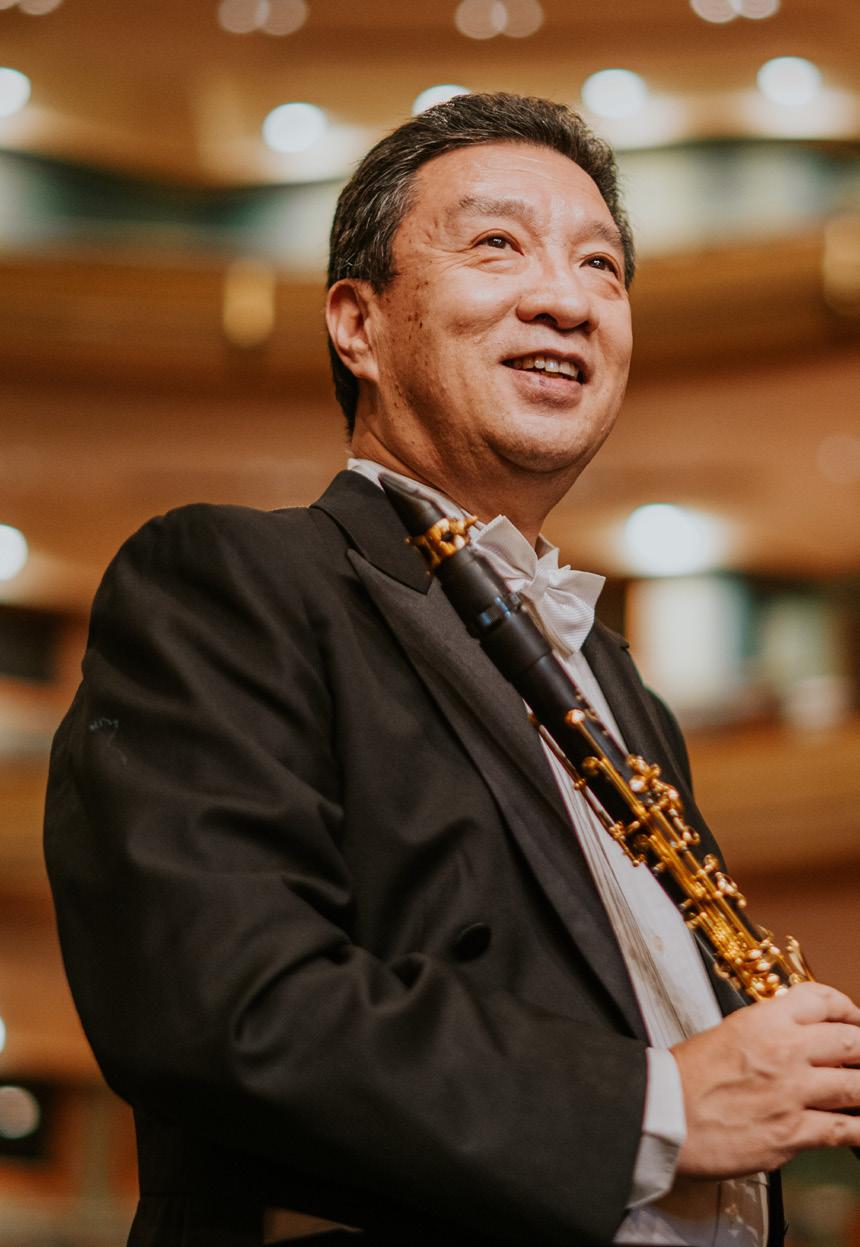
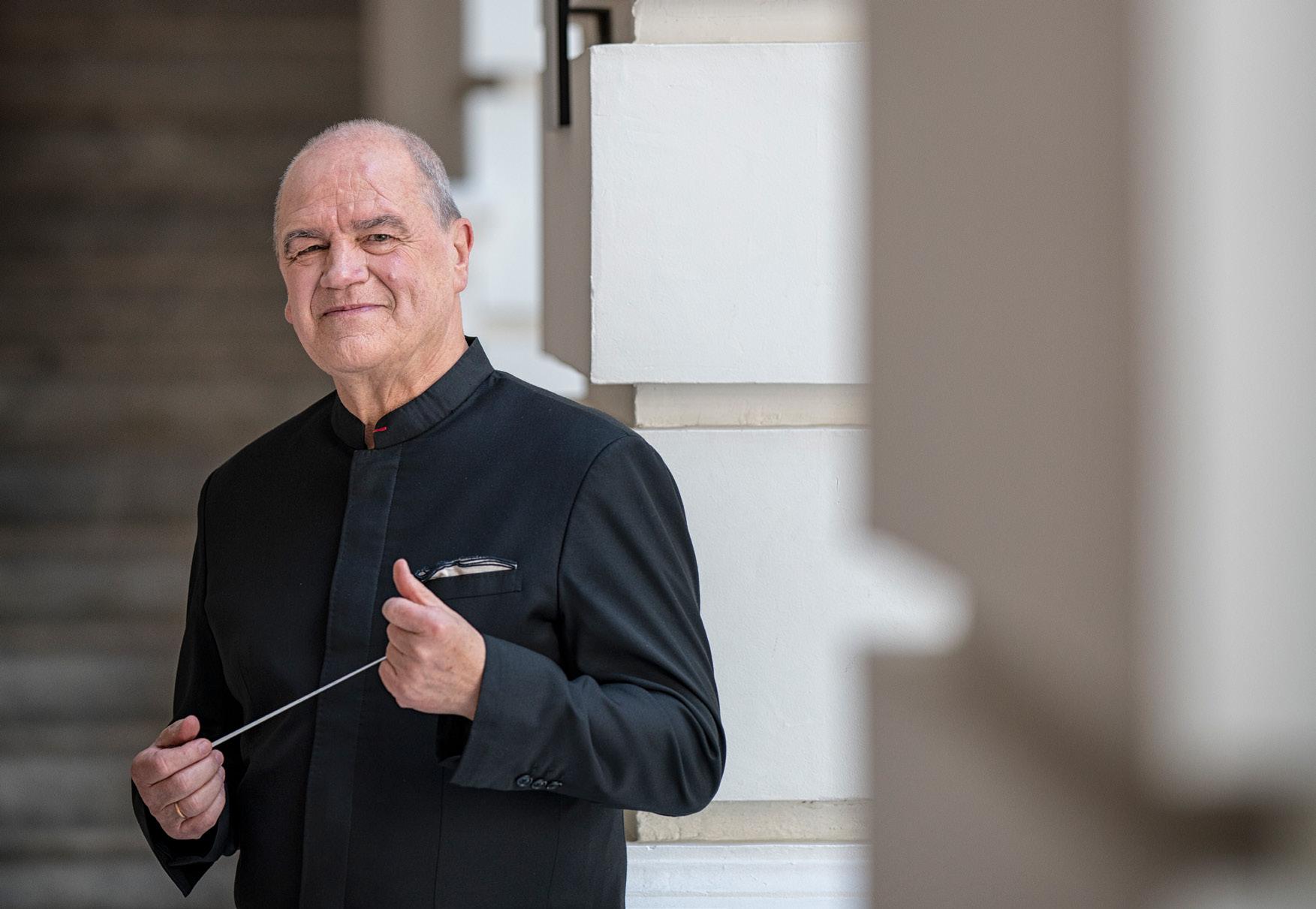

Armed with a spirit of musical curiosity and discovery, creative programming and his commanding presence on stage, Austrian conductor Hans Graf has raised orchestras to new heights while winning audiences young and old alike. With Hans Graf, the Singapore Symphony Orchestra (SSO) has achieved “a brave new world of music-making under inspired direction” (The Straits Times) since his appointment as Chief Conductor in the 2020/21 season, followed by five outstanding seasons as Music Director. Hans Graf’s farewell season in 2025/26 celebrates his remarkable achievements with his being named the SSO’s first Quantedge Music Director.
Graf was formerly Music Director of the Houston Symphony, Calgary Philharmonic, Orchestre National Bordeaux Aquitaine, Basque National Orchestra and Mozarteum
Orchestra Salzburg. He is a frequent guest with major orchestras and opera houses worldwide, receiving the Österreichischer Musiktheaterpreis award at the famed Vienna Volksoper in 2014.
Hans Graf’s discography includes extensive surveys of Mozart, Schubert and Dutilleux, as well as a GRAMMY and ECHO Klassik award-winning recording of Berg’s Wozzeck With the Singapore Symphony, Graf has recorded works by Paul von Klenau, Mozart, Stravinsky and his own edition of Kozłowski’s Requiem.
Hans Graf is Professor Emeritus at the Universität Mozarteum, Salzburg, and a recipient of the Chevalier de l'Ordre de la Légion d'Honneur (France) and the Grand Decoration of Honour (Austria).
Eudenice Palaruan studied at the University of the Philippines College of Music, majoring in composition and choral conducting. He took further training in choral conducting at the Berliner Kirchenmusikschule, Germany. He graduated doctor of musical arts at St. Paul University Manila.
He was a singer, resident composer/arranger, and assistant choirmaster of the Philippine Madrigal Singers. In addition, he performed with the Berlin Spandauer Kantorei, the World Youth Choir, and sang countertenor with the Berlin Monteverdichor.
In addition, he was the principal conductor of the San Miguel Master Chorale. For years, he has been the resident conductor of the International Bamboo Organ Festival, where he performed and recorded significant selections of Latin-American baroque music. With his active involvement in the choralization of Philippine and other Asian indigenous music, he premiered a substantial volume of new Asian choral works. In addition, he was often invited to give lectures on non-Western vocal aesthetics.
Eudenice also arranges for the SSO choruses and the SSC community outreach programmes. In addition, the SSO choruses have premiered new choral works written by local composers and arrangers in Singapore under his direction.
He taught composition and choral conducting in institutions such as the University of the Philippines College of Music, the Asian Institute for Liturgy and Music, and St. Paul University College of Music and the Performing Arts. In addition, he teaches at the Singapore Bible College School of Church Music and directs the SBC Chorale. Eudenice is often invited to adjudicate in international composition competitions and give masterclasses in choral conducting.
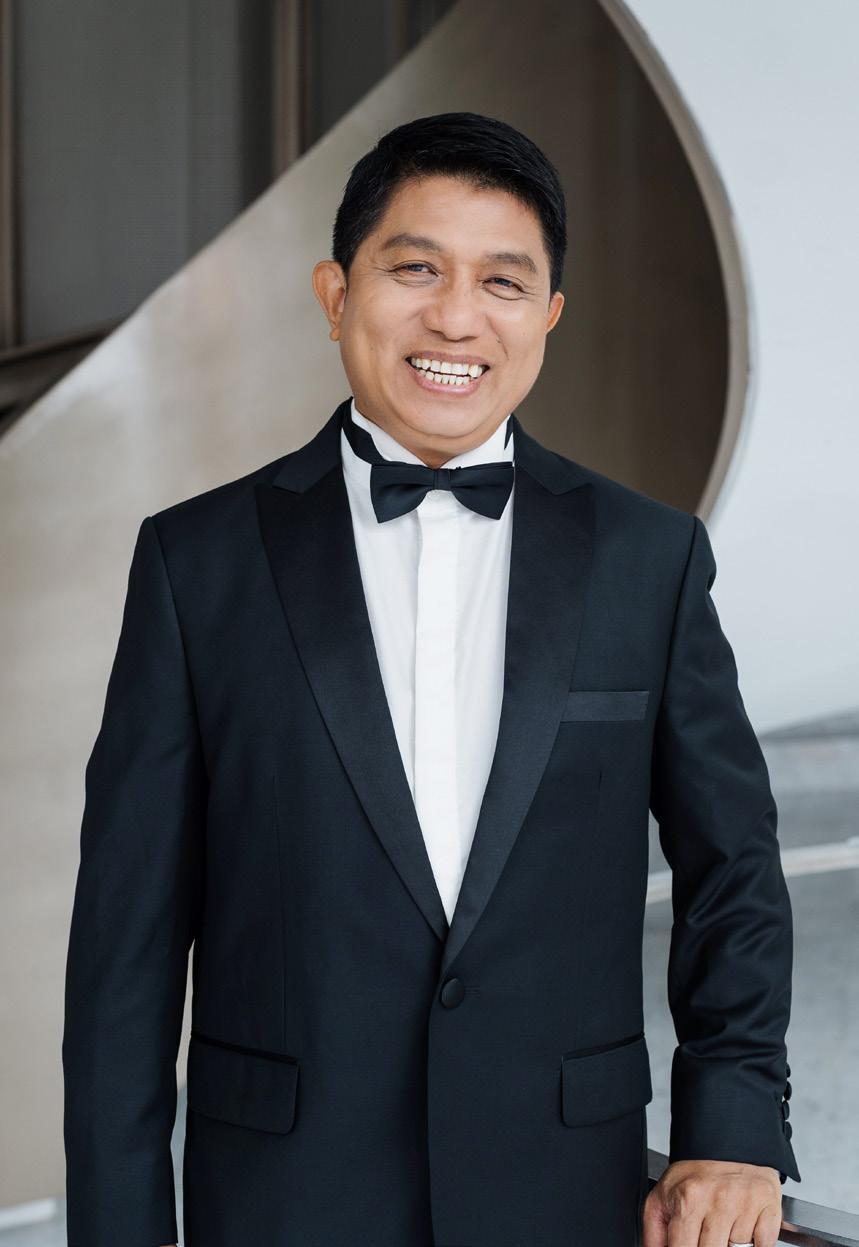
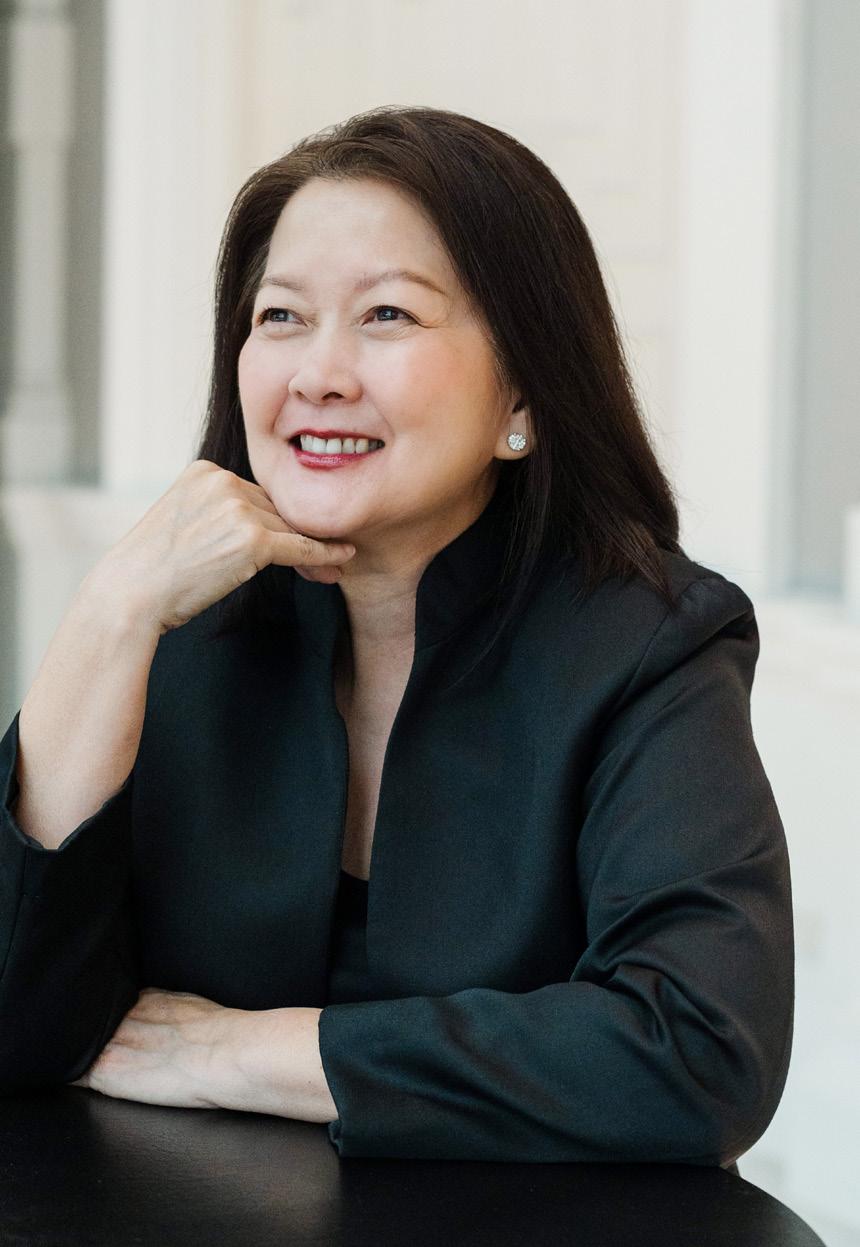
© JACK YAM
Wong Lai Foon has been a driving force behind the development and growth of the Singapore Symphony Children’s Choir (SSCC) since its inception in 2006. Appointed Choirmaster in 2015 and armed with a mission to nurture young voices and inspire choral excellence, she led in the expansion of the SSCC’s training programme to include six preparatory ensembles, as well as the formation of the Singapore Symphony Youth Choir in 2016.
With repertoire ranging from Baroque to opera to contemporary and popular music, she has directed the SSCC and SSYC in a wide array of concerts, often receiving praise for the choirs’ beautiful tone and sensitivity. She has prepared the choirs in collaborations with renowned conductors and performers such as Stephen Layton, The King’s Singers, and Sofi Jeanin and la Maîtrise de Radio France. The SSCC has also had the distinction of being invited to perform at state functions.
Wong has commissioned and premiered treble choir works by local composers and has also arranged for the SSCC and SSYC. Her efforts to educate and inspire singers extend into the community through workshops, talks, as well as adjudicator, chorus-master and guest-conductor roles. Some ensembles that she has worked with include The Philharmonic Chamber Choir, Singapore Symphony Chorus, Singapore Lyric Opera, Hallelujah Singers, and Methodist Festival Choir. She holds a master’s degree in choral conducting from Westminster Choir College, USA.
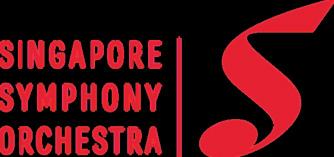



A premier body for classical choral singing, the Si ngapore Symphony Choruses comprise the Singapore Symphony Chorus, Si ngapore Symphony Youth Choir and Singapore Symphony Childre n’s Choir.
Drawing membership from diverse ages, nationalities and walks of life, our Choruses embody a comprehensive singing ecosyst em that nurtures the brilliance of our brightest young talents, insp ires youthful passion for the art and celebrates the best of choral excel lence!

Scan the QR code and visit our website for more det ails on audition and training opportunities.
@singaporesymphony
@sgsymphonychorus
@sgsymphonyyouthchoir
@sgsymphonychildrenschoir
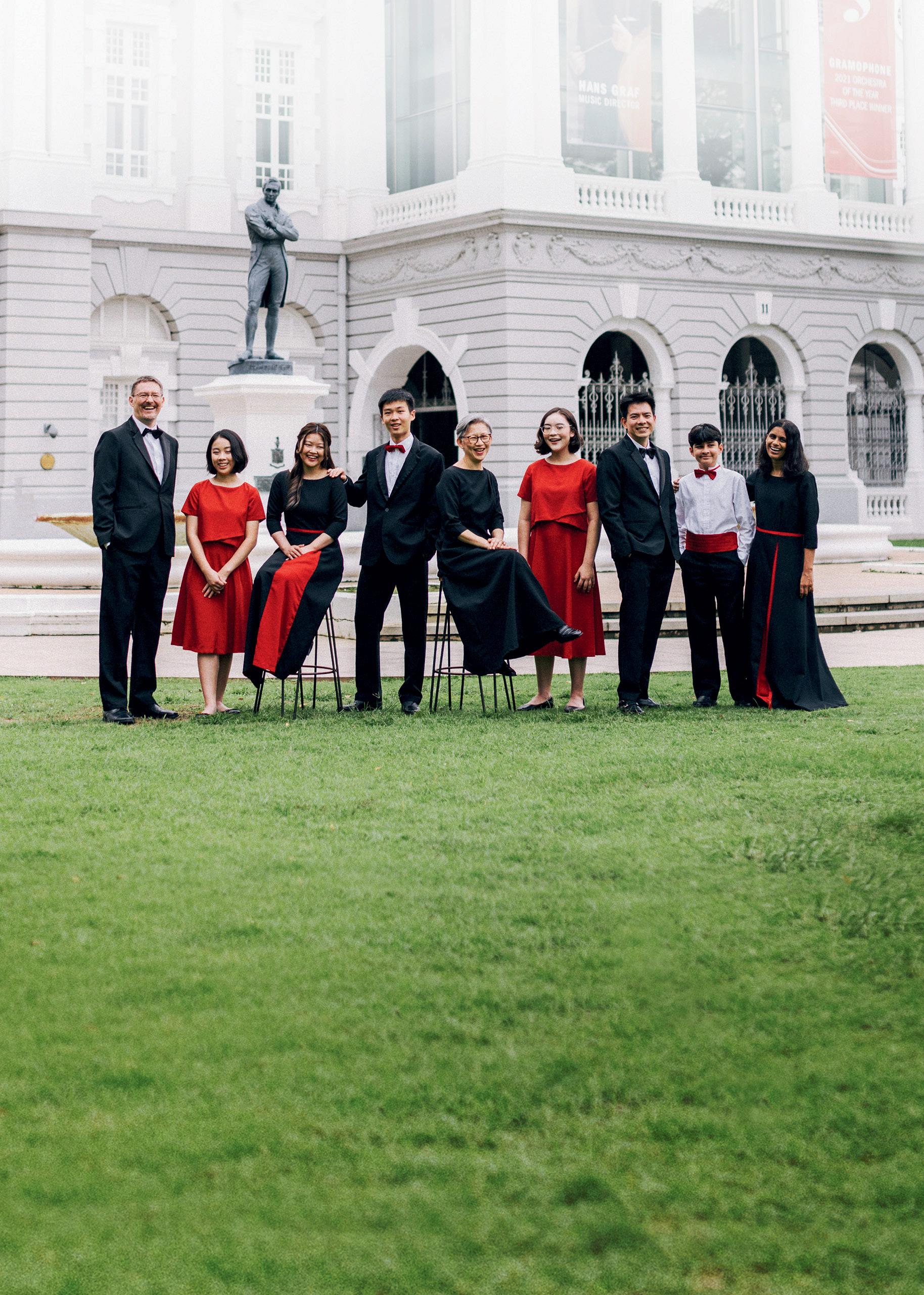

Scan for more information Or visit our website at sso.org.sg/choruses

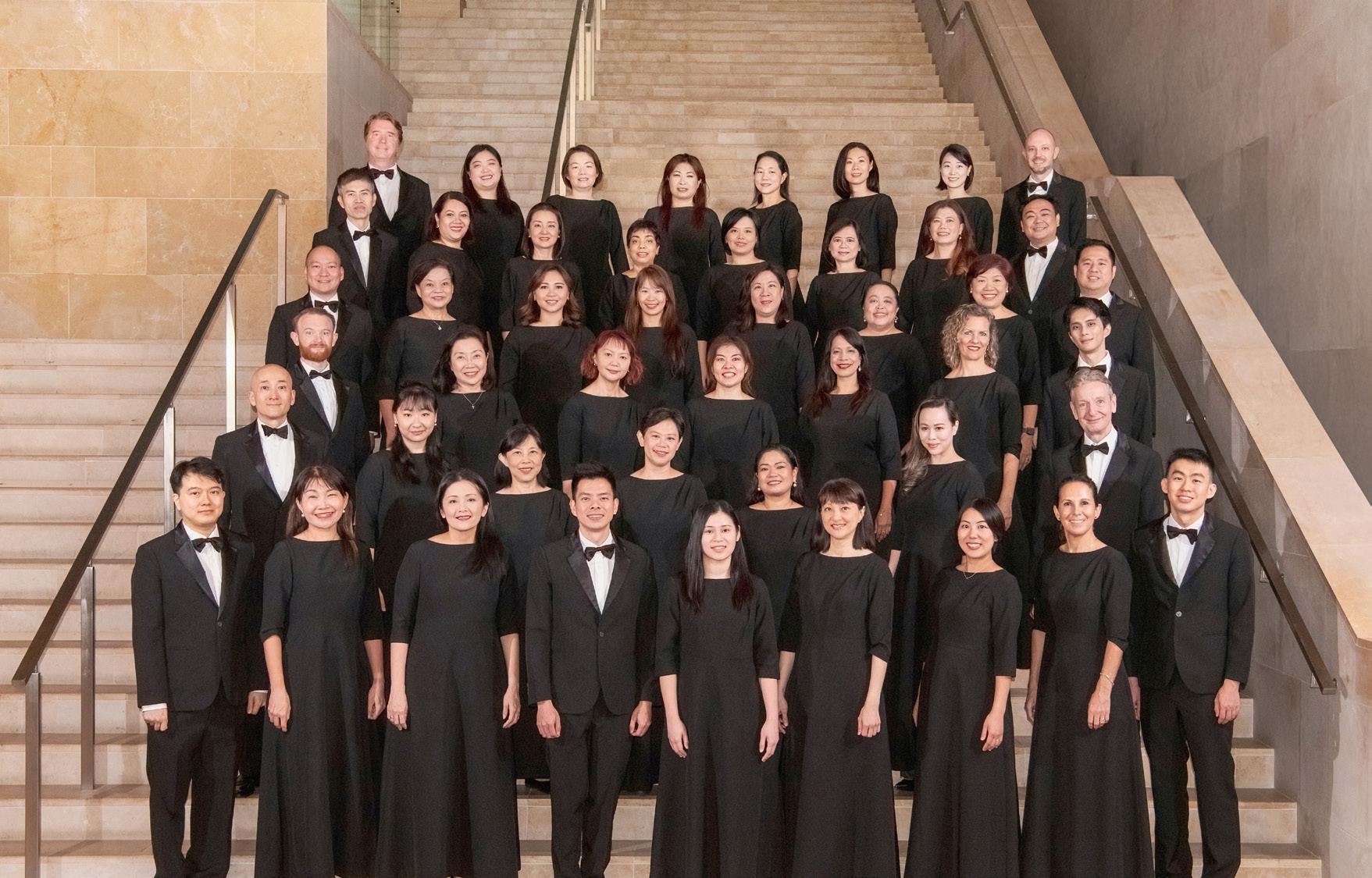
For over four decades, the Singapore Symphony Chorus (SSC) has been bringing together passionate and talented choristers from all walks of life to celebrate the best of symphonic music-making, and to create music that moves, transcending language and culture.
More than just a choir, the SSC is a warm and vibrant community for lifelong social connections beyond the stage. Seasoned performers at the Victoria Concert Hall and the Esplanade, the
chorus’s committed group of singers come together week after week to hone their artistry and volunteer their time to deliver some of the most challenging choral classics to the highest standards.
Led by world-class conductors including Okko Kamu, Lan Shui, Lim Yau, Masaaki Suzuki and Sofi Jeannin, the chorus has amassed an impressive repertoire such as Tippett’s A Child of Our Time, Arvo Pärt’s Te Deum, Britten’s War Requiem, and Bach’s St John Passion, amongst others, since its founding in 1980.
With their dedication towards presenting outstanding performances, the SSC is the pinnacle of choral excellence in Singapore and a testament to the power of music and how it connects people across cultures and generations.
Eudenice Palaruan Choral Director
Ellissa Sayampanathan Assistant Choral Conductor
Ng Sheh Feng Choral Associate
Wong Yang Kai Choral Associate
Shane Thio rehearsal pianist

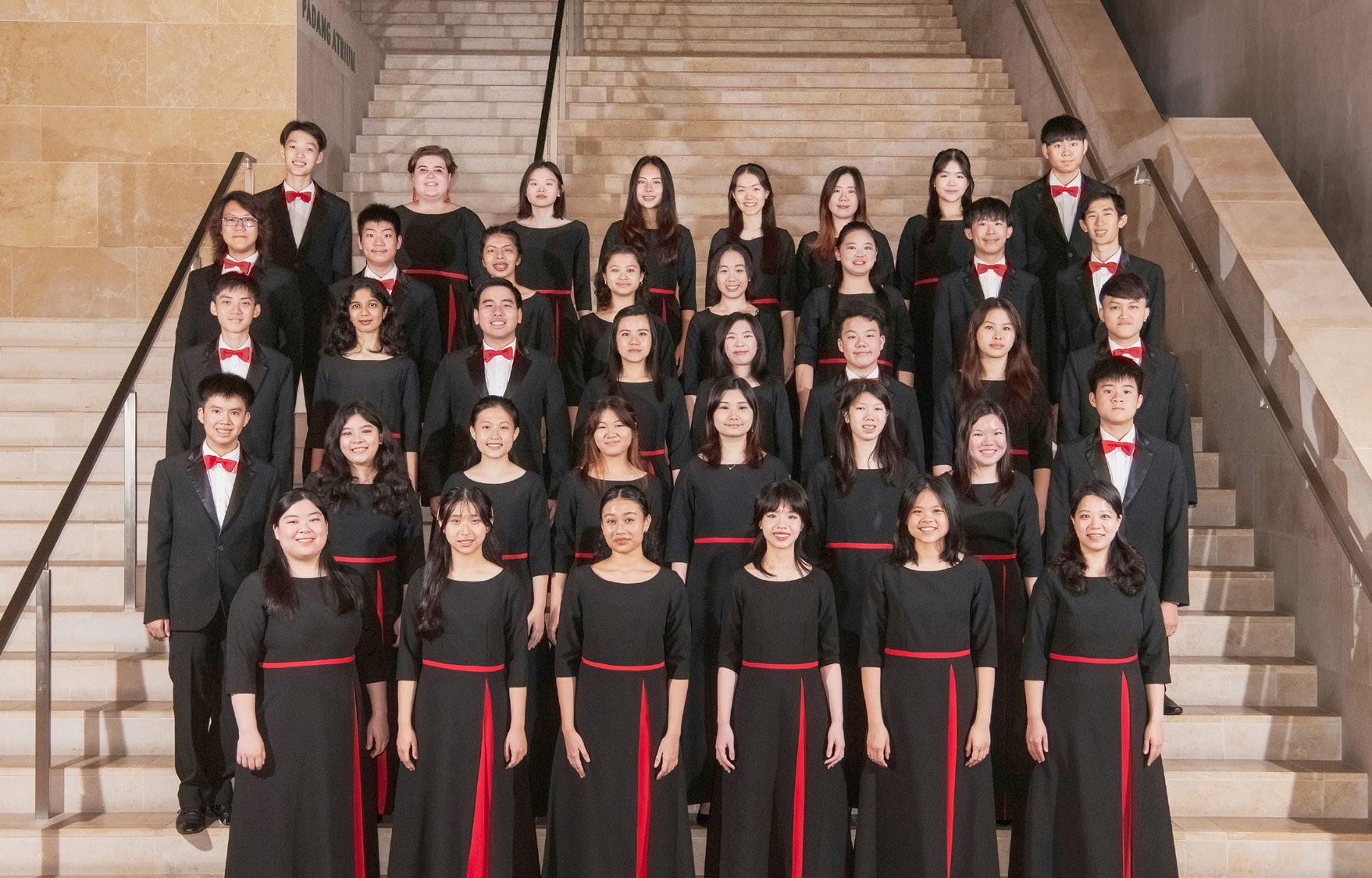
Energetic and full of dynamism, the Singapore Symphony Youth Choir (SSYC)’s choristers embody a zeal for artistic growth that inspires and pushes boundaries.
Comprised of a myriad of vibrant personalities aged between 17 and 28, the cool collective welcomes like-minded singers to share their journey of youthful passion for symphonic choral music-making, alongside the national orchestra! Performing regularly at the Victoria Concert Hall and the Esplanade, the SSYC is a group of dedicated singers who enjoy coming together to explore some of the most challenging and beloved choral works across styles and genres.
Since 2016, SSYC has had the privilege of performing under the baton of renowned conductors such as Lan Shui, Hans Graf, and Stephen Layton. Their repertoire boasts of musical highlights including Scriabin’s Prometheus, Puccini’s La Bohème, Tallis’s Why Fumeth in Fight, Faure’s Requiem and
recordings of Borodin’s Polovtsian Dances and Mahler’s Symphony No. 2.
With the unique opportunity to learn from world renowned musicians and be part of a community that inspires passion, all while creating a professional sound, SSYC is a social journey to reimagine classical music and choral excellence.
Wong Lai Foon Choirmaster
Ellissa Sayampanathan Assistant Choral Conductor
Evelyn Handrisanto rehearsal pianist
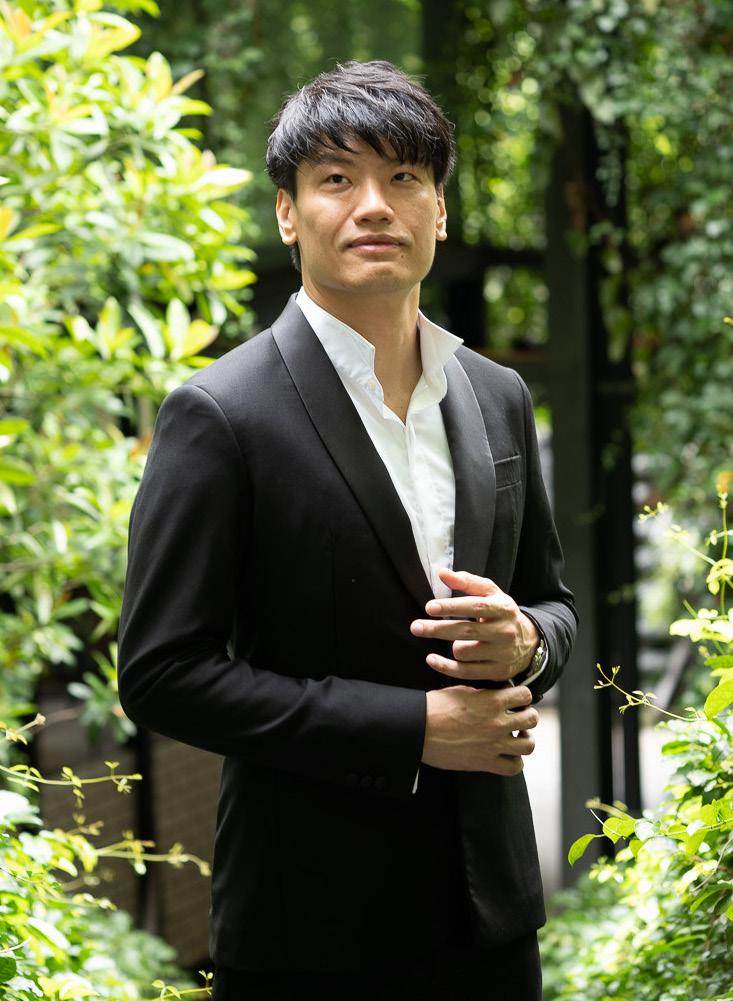
Trumpeter-turned-chorister Chong Wai Lun found his calling in serving the music and his fellow musicians as a conductor.
After studying at the Kodály Institute of the Liszt Ferenc Academy of Music (Hungary), he pursued his Master’s Degree in choral conducting at the Royal Welsh College of Music & Drama in Cardiff, Wales (United Kingdom).
Upon his return to Singapore, Wai Lun was appointed the Music Director at the International Festival Chorus of Singapore (IFC) from 2015 to 2019. He currently dedicates his time to nurturing the choirs at Ahmad Ibrahim Secondary School and Temasek Secondary School.
At his alma mater Yong Siew Toh Conservatory of Music, Wai Lun is both an adjunct faculty member (directing the YST Chamber Singers) and an alumni who studied orchestral conducting under the guidance of Jason Lai.
Wai Lun is also founder and Chorus Master of the Symphonia Choralis, a professional freelance choir that collaborates extensively with the Metropolitan Festival Orchestra.

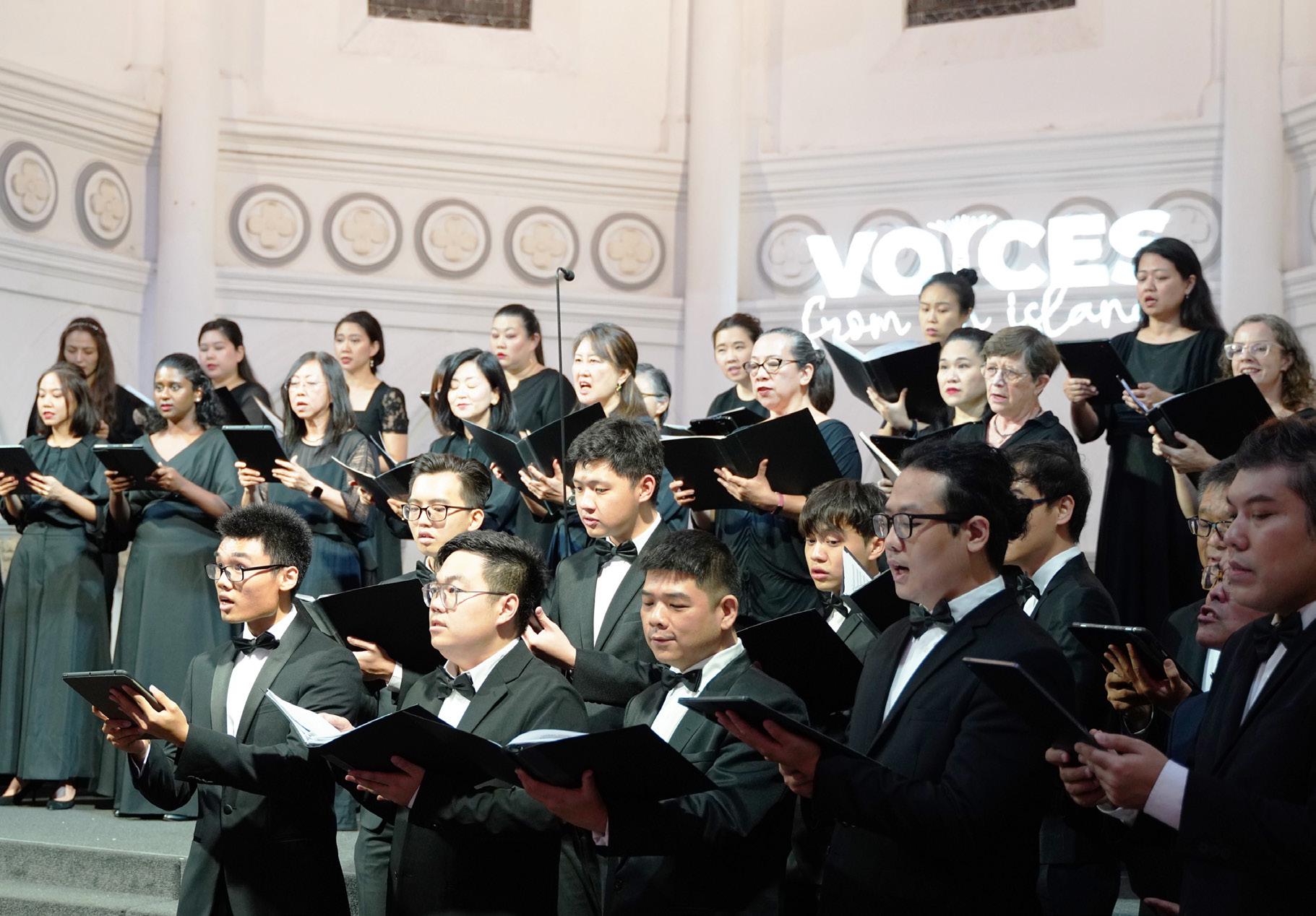
A synthesis of “symphony” and “choir”, Symphonia Choralis is a project chorus founded by its music director Chong Wai Lun in 2017. The chorus’ inaugural performance was of Elgar’s The Music Makers with the Orchestra of the Music Makers, alongside Taipei Philharmonic Chorus. Subsequently, they were also part of the Singapore premiere of Bernstein’s Mass (2018), and Walton’s Belshazzar’s Feast (2019).
Symphonia Choralis is known for its assurance for quality, versatility and professionalism — it has collaborated with other major institutions such as: Philharmonic Winds, Base Entertainment, Singapore Ballet, New Opera Singapore and Musicians’ Initiative.
Symphonia Choralis is the chorus of choice for Metropolitan Festival Orchestra’s performances of notable IPs, namely Disney’s Frozen, Harry Potter and the Prisoner of Azkaban, Kingdom
Hearts, Sarah Brightman’s A Christmas Symphony and Hans Zimmer’s World Tour.
2024 was a highlight year of Elden Ring, Genshin Impact, Final Fantasy VII, Disney’s Lion King and Aladdin. The exciting lineup continued in 2025 when the chorus performed music from Marvel’s Cinematic Universe and Grammy-Award winning La La Land in Singapore.
The chorus continues to bring together freelance musicians across Singapore for orchestral performances involving choruses, uniting vocalists from leading choirs to share the joy of choral music making with all.
Mahler’s Resurrection Symphony
23 & 24 May 2025
Singapore Symphony Chorus
Soprano
Karen Aw
Josephine Budiana
Janice Chee
Alexis Chen
Chia Gin Gin
Elizabeth Daniel
Julie Demange Wodtke
Grace Goh
Vivien Heng
Kaitlyn Kim
Selina Kwek
Rachel Lam
Sun Lee
Aidah Lim
Liang Xinyu
Ng Bee Kay
Sarah Santhana
Andrea Yenny Sjah
Nelia Soelistia
Stacey Wang Espera
Vivienne Tan
Sarah Tang
Sachiko Tomimori
Gladys Torrado
Wang Yu-Ann
Alto
Grace Angel
Chan Mei Yoke
Joy Chen
Chng Xin Bei
Marie Amelie McKeand
Friederike Herrmann
Truly Hutapea
Susan Kurniawati
Dorothy Lee-Teh
Wendy Lim
Lin Wei
Low Shoumin
Sharon Low
Sylwia Mirucka
Ng Beng Choo
Ng Sheh Feng*
Natividad Solaguren
Ena Su
Ratna Sutantio
Elsie Tan
Tan Seow Yen
Rina Ushioda
Wang Jiun Wen
Nadine Yap
Tenor
Jean-Michel Bardin
Jesse Cai
Chong Wei Sheng
Ivan De Jesus
Adrian Lim
Elton Lin
Jeroven Marquez
Ronald Ooi
Samuel Pazicky
Rac Roldan
Ian Tan
Ben Wong
Yek Kwan
Bass
Ang Jian Zhong
Vincent Chiu
Winsen Citra
Craig Chambers
Arthur Davis
Paul Ellison
Andy Jatmiko
Ethan Jerzak
Paul Kitamura
Justin Lee
Yen Phang
Jared Robertson
Teo Siak Hian
Elliott Titcombe
Michael Walsh
Wong Hin Yan
Wong Yang Kai*
*Choral Associate
Soprano
Cham Li Teng
Halyn Cho
Goh Chen Xi
Jocelyne Harefa
Emily Hia
Rachael Jong
Emma Lee-Goh
Melina Leong
Giselle Lim
Ng Yi Poh
Teryn Rim
Desiree Seng
Samyukta Sounderamann
Tan Caewyn
Carine Tan
Christabelle Tan
Janelle Tan
Jasmine Towndrow
Raeanne Wong
Shuwen
Chloe Zhou
Alto
Dieh Xin Xin
Megan Fung
Elizabeth Goh
Trinetra Kumarasan
Zoe Li
Zachary Lim
Ong Sherlyn
Suri Rao
Tan Yuqing
Tan Yulin
Elizabeth Yeo
Tenor
Hann Lyang
Alfonso Yuji Cortez
Daniel Lee
Amos Pan
Seifer Ong
Stanley Yuan
Soprano
Jody Ang
Chan Xing Yun
Amelia Faith Dizon
Hillary Gracia
Lim Cher Hui
Priscilla Lim
Estelle Ng
Jessy Ng
Caerissa Tung
Wan Yuting Melissa
Laura Wang
Alto
Colette Chai
Jamie Chan
Cecilia Chong
Tabitha Chong
Joanna Deakin
Martha Fernandez
Vanessa Goh
Tomoko Ichimaru
Koh Wee Ling
Lim Geok Choo
Mona Lim
Gwyneth Long
Diane Ng
Elaine Ser
Tay Hwee Ling
Tham Yun Yi
Wee Hong Hong
Rachel Wong
Marissa Yee
Bass
Leonard Buescher
Chai Chang Kai
Matthew Chiang
Liu Felix
Loy Sheng Rui
Dominic Tang
Tan Hee
Joshua Tan
Wong Zhen Wei
Tenor
Chan Long
Hor Xinrong
Jon Loh
Gerald Paul Tan
Mark Tan
Wang Guoli
Bass
Chia Chee An
Aaron D’alwis
Enzo Buttazzoni
Nicholas Goh
Heng Javier
Kirk Chin Ho
Lee Kah Hong Bernard
Aaron Liew
Lum Shao Farn
Sean Pang
Seow Kai Yuan Ethan
Marcus Teng
Wong Shee Hoong
Xiao Chunyuan
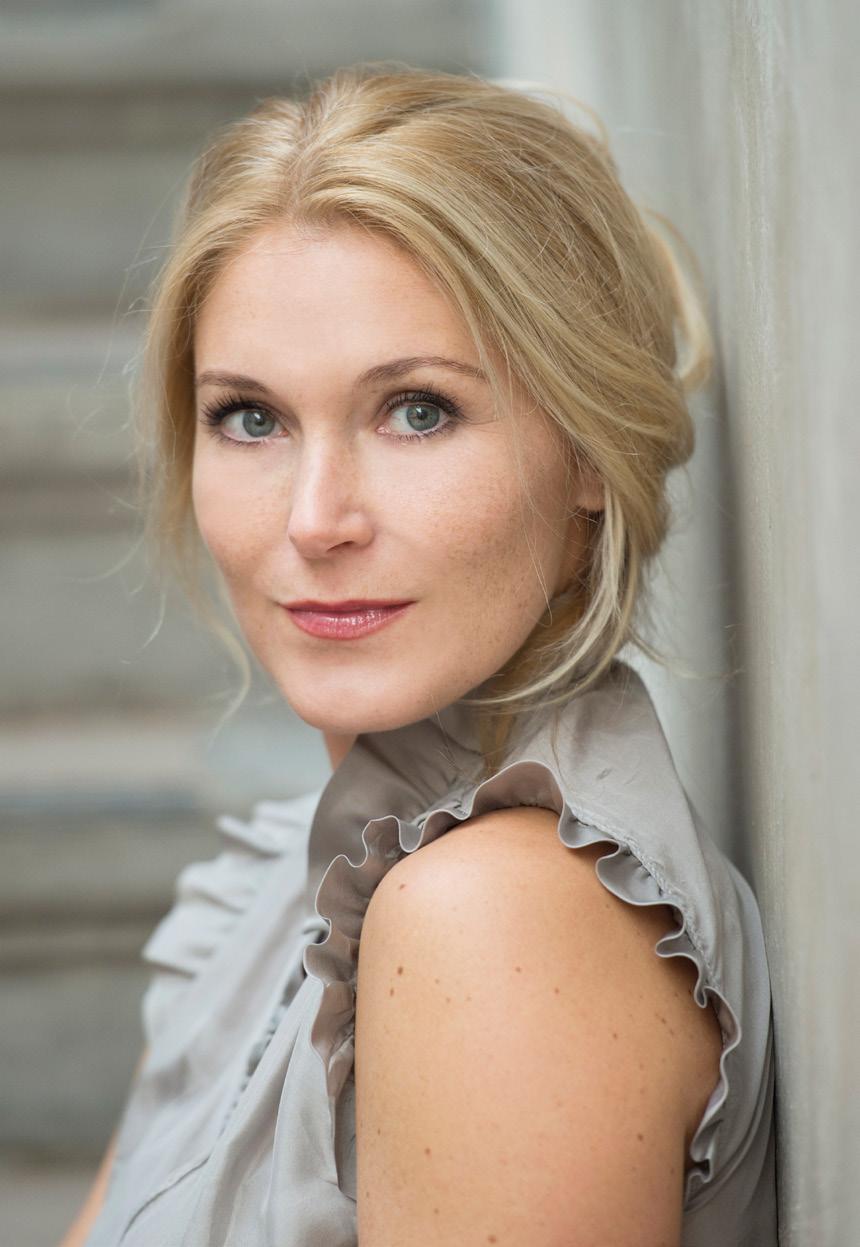
Maria Bengtsson begins the 2024/25 season as Christine in a new production of Intermezzo at the Sächsische Staatsoper Dresden, followed by a revival of the opera at the Deutsche Oper Berlin. She sings La Contessa (Le Nozze di Figaro) at the Royal Opera House London and the Munich State Opera in July 2024, as well as Donna Anna (Don Giovanni) in the Vienna State Opera’s guest performance at the Opéra de Monaco. Further engagements include the Marschallin (Der Rosenkavalier) at the Frankfurt Opera.
Concert appearances take her to the Berlin Radio Symphony Orchestra (Knoxville: Summer of 1915), Strauss’s Four Last Songs in Malmö and Hamburg (Bertrand de Billy), Zemlinsky’s Lyric Symphony with the Bavarian Radio Symphony Orchestra (Simone Young), and Mahler’s Symphony No. 2 with the Singapore Symphony Orchestra.
Recent highlights include Daphne (Frankfurt Opera), the Marschallin (Rosenkavalier) in Geneva and Amsterdam, Contessa (Nozze di Figaro) in Paris and Berlin, Donna Anna (London), Blanche (Dialogues des Carmélites), Ellen Orford (Peter Grimes), Rusalka, and the title role in Detlev Glanert’s world premiere Oceane (Deutsche Oper Berlin).
A renowned concert and Lied interpreter, she has performed at Vienna Musikverein, Leipzig Gewandhaus, Alte Oper Frankfurt, and the Elbphilharmonie.
Bengtsson studied in Freiburg and was an ensemble member at the Vienna Volksoper and Komische Oper Berlin, where she appeared in the leading roles under Kirill Petrenko in many of his most important productions, before launching her freelance career in 2007. Since that time she has appeared, among others, at Opéra de Paris, Covent Garden, La Scala, the Teatro la Fenice, the Salzburg and Aix-en-Provence Festivals, and the Bolshoi.
Tanja Ariane Baumgartner is one of the leading mezzo-sopranos of our time. With roles such as Fricka (Rheingold/Walküre), Kundry (Parsifal), Klytämnestra (Elektra), the Nurse (Die Frau ohne Schatten), and Ortrud (Lohengrin), she has established herself at the most important international opera houses and festivals.
The 2024/25 season started with her house debut at La Scala in Milan as Annina (Der Rosenkavalier) under Kirill Petrenko. She returns to Geneva as Herodias (Salome) and appears as Kundry at the Tokyo Spring Festival, where she also sings the alto part in Beethoven's Missa Solemnis. Concert engagements include performances with the Vienna Symphony Orchestra in Mahler’s Symphony No. 8 (Philippe Jordan), the Czech Philharmonic Orchestra (Semyon Bychkov), and the Singapore Symphony Orchestra (Mahler’s Symphony No. 2).
Recent highlights include Ortrud, Fricka, Brangäne, and the Nurse at the Vienna State Opera, Mrs. Quickly (Falstaff), Charlotte (Die Soldaten), and Madre (Il prigioniero) at the Salzburg Festival, as well as Venus (Tannhäuser) in Hamburg and Zurich. Further engagements have taken her to Munich, Berlin, London, Edinburgh, and Santiago de Chile.
From 2009 to 2020, she was a member of the Frankfurt Opera ensemble, where she performed leading roles such as the title role in Schoeck’s Penthesilea, Eboli (Don Carlo), Azucena (Il Trovatore), and Clairon (Capriccio).
As a concert soloist, she has performed with major orchestras worldwide, including the Munich Philharmonic, the Orchestre Philharmonique de Radio France, and the Concertgebouworkest.
Tanja Ariane Baumgartner first studied violin in Freiburg before pursuing vocal studies in Karlsruhe, Vienna, and Sofia. She is a professor of singing at the Bern University of the Arts.
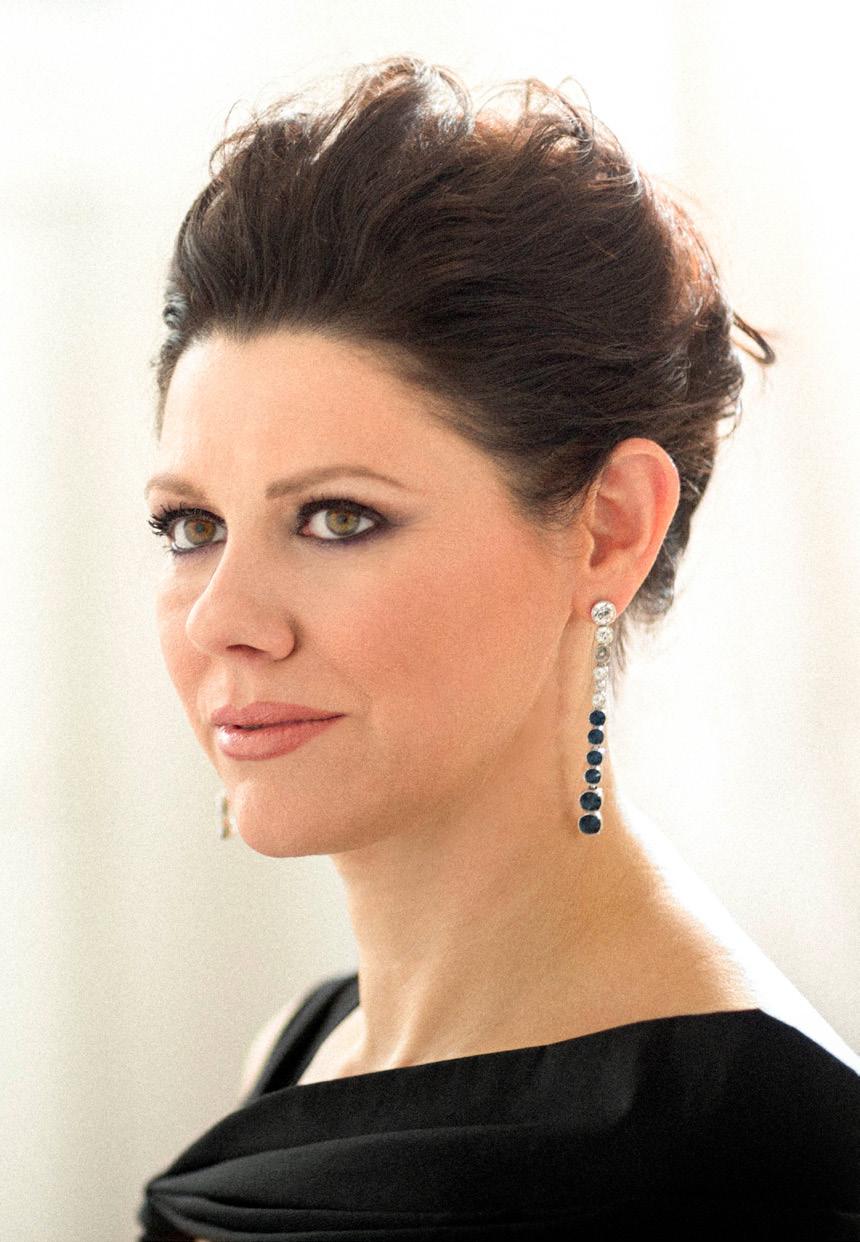
Fri & Sat, 2 & 3 May 2025
Victoria Concert Hall
Singapore Symphony Orchestra
Rodolfo Barráez Associate Conductor
Ma Yue clarinet*
Angela Chan Guest Concertmaster
Mozart
Symphony No. 35 in D major, K. 385 “Haffner” 18 mins
Finzi
Clarinet Concerto, Op. 31* 30 mins
Intermission 20 mins
Mozart
Symphony No. 39 in E-flat major, K. 543 29 mins
Concert Duration: approximately 1 hr 50 mins (including 20 mins intermission)

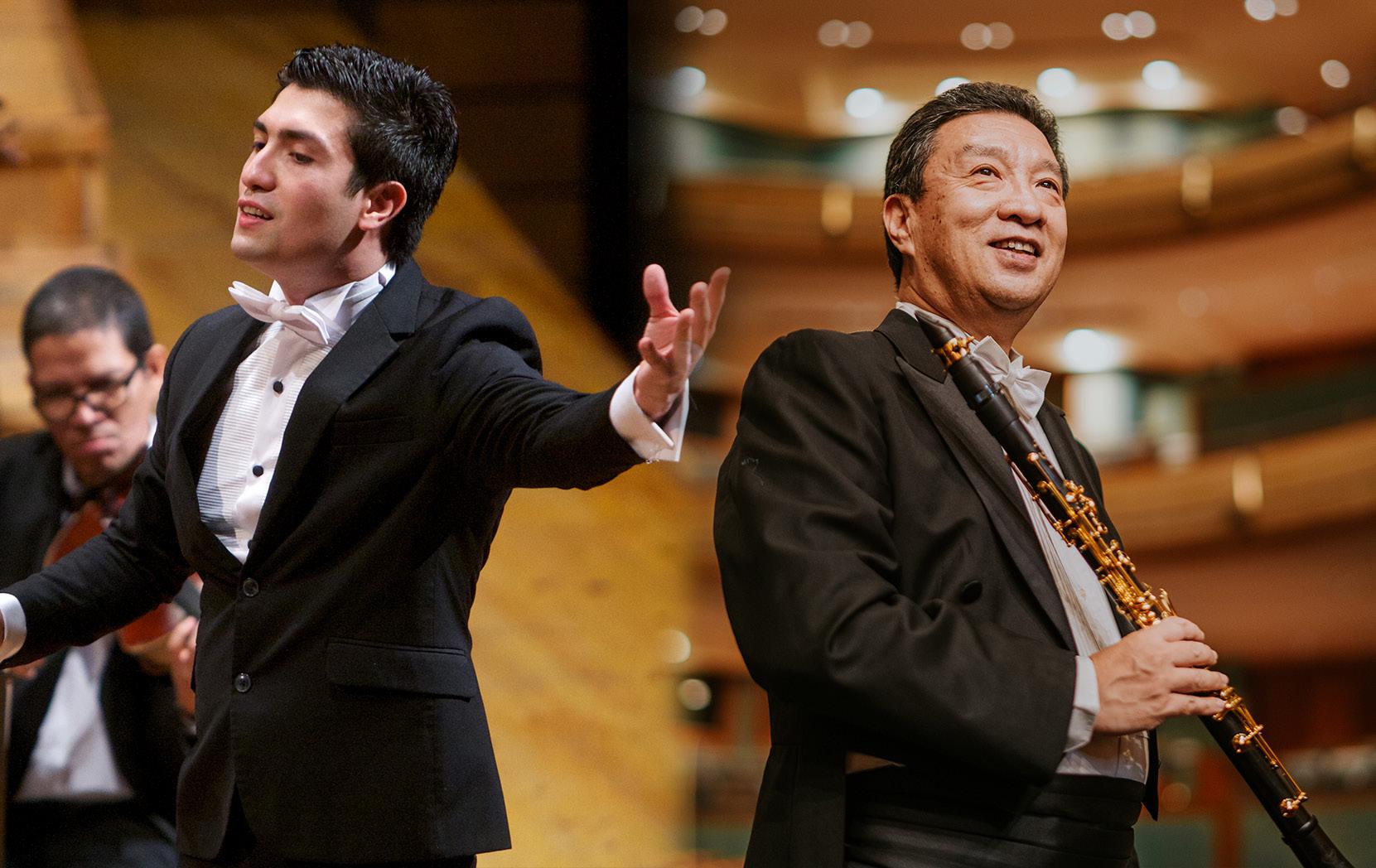
Check-in to tonight's concert
Scan this QR code with the Singapore Symphony Mobile App.
1756–1791
Symphony No. 35 in D major, K. 385 “Haffner” (1782)
Menuetto – Trio Finale: Presto I II III IV
Allegro con spirito Andante
If Haydn was the father of the symphony, Mozart would have been his childhood best friend and partner in all sorts of madcap adventures, for Mozart pushed the form and content of the developing genre into new territories hitherto unexplored. The Symphony No. 35 in D major, K. 385, “Haffner”, was composed in 1782, at a time when life was going rather well for young Wolfgang. In the previous year, 1781, Mozart had extricated himself from the service of Archbishop Colloredo of Salzburg and settled in Vienna, where he became a freelance performer and composer.
In July 1782, Mozart’s father Leopold tasked him to write a new serenade for their family friend Sigmund Haffner the Elder, a wealthy businessman and former mayor of Salzburg, for whose daughter’s wedding some years earlier Wolfgang had written his Haffner Serenade. As Haffner’s son Sigmund the Younger was to receive a minor noble title, new music was required for a concert, and family obligation ensured Wolfgang produced the work to order, between arranging his new opera The Abduction from the Seraglio for wind instruments and numerous teaching engagements. The work was posted to Salzburg movement by movement as he completed them, and by the time the last movement was sent off, Mozart was also busy preparing for his own wedding on 4th August to Constanze
Weber. Whether he met the deadline for the ennoblement ceremony is unknown, but at any rate Mozart requested the music back from his father in December 1782, intending to present it in Vienna. The serenade was then reworked and reorchestrated, becoming the Haffner Symphony, premiering on 23 March 1783 in the presence of Emperor Joseph II, who contrary to his usual custom, stayed for the whole concert.
“Mozart pushed the form and content of the developing genre into new territories”
The symphony opens Allegro con spirito with fiery rushing chords interrupting the developing themes, giving an almost minor-key dramatic edge, but otherwise unfolds in typical sonata form. The serious Andante moves into G major, giving us soothing strings punctuated by insistent woodwinds, but despite the rather
busy accompaniment, retains a feeling of elegant calm. The requisite Menuetto – Trio brings us back to D major, with an exuberant opening section followed by a lilting countrydance trio. The vigorous Finale may contain a hidden message, for its main theme is notably similar to that of “Ha! Wie will ich triumphieren” (“Ha! How I shall triumph”), a comic aria from his recently completed opera The Abduction from the Seraglio. Was Mozart thus thumbing his nose at Salzburg and its archbishop, who had dismissed him literally with a “kick to the arse”? Given his sense of impish humour, we may well wonder.
Instrumentation
2 flutes, 2 oboes, 2 clarinets, 2 bassoons, 2 horns, 2 trumpets, timpani, strings
World Premiere 23 Mar 1783, Vienna
First performed by SSO 14 Nov 1980
1901–1956
Clarinet Concerto, Op. 31 (1949)
Allegro vigoroso
Adagio, ma senza rigore
III
Rondo: Allegro giocoso
Perhaps best known as a choral composer, British composer Gerald Raphael Finzi was born in London to a family of Jewish descent. His formative years were marked by tragedy—his father died a fortnight before his eighth birthday, he was to lose all three of his brothers, and his first music teacher died fighting on the Western Front. Seeking solace in music and poetry, he began setting poems to music, most of which was elegiac in tone, with a sense of the fleeting nature of life. Despite being rejected by Charles Villiers Stanford for study at the Royal College of Music, he moved to London and became acquainted with Gustav Holst, Arthur Bliss, and most importantly Ralph Vaughan Williams, who obtained a teaching post for him at the Royal Academy of Music from 1930 to 1933. He later moved to Wiltshire, where he focused on composing music and cultivating 350 varieties of English apples, as well as establishing a massive collection of nearly 4,000 books, manuscripts, and scores across the genres of music, poetry, philosophy, and literature.
At the end of World War II, Finzi composed the Clarinet Concerto, Op. 31. This was to be premiered at the Three Choirs Festival on 9th September 1949 by clarinetist Frederick Thurston, with Finzi himself conducting. The music opens in C minor with an Allegro vigoroso, with twisted harmonies and a generally bleak atmosphere, before the clarinet enters and writhes, pulling the music
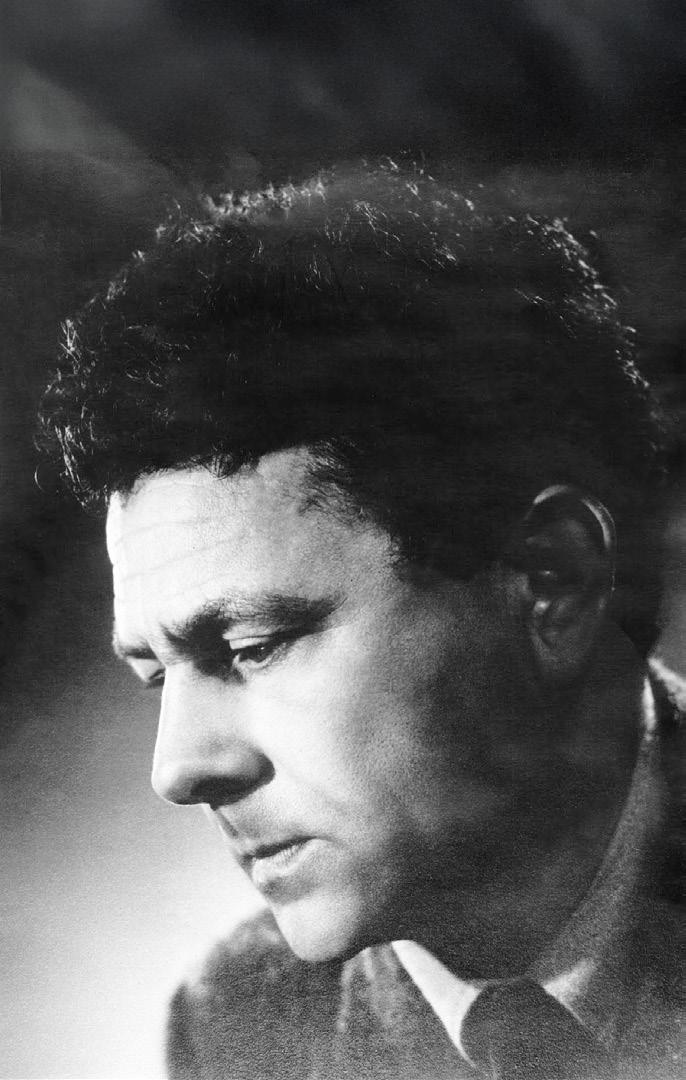
in a gentler and undulating way. Unperturbed by the orchestra’s repeated attempts to stir it up, the clarinet soothes the flow of the music, calming it down. Perhaps one may see here a powerful image of a young Finzi, serenely seeking order and peace amidst the storms of his early life. A cadenza uniting both turbulence and gentleness precedes the final bars of the movement.
The Adagio, ma senza rigore presents us with an arresting landscape in which we may meditate on the impermanence of all things, with the clarinet serving as our Virgil through the ebb and flow of the ghostly images presented by the orchestra. Finzi finally gives us a major-key respite in the Rondo: Allegro giocoso, when the clarinet presents a folksonglike theme that is developed extensively and keeps returning amidst the attempts by the orchestra to drive things in a more serious direction. The clarinet brings back the serene first melody from the opening movement before ending the concerto with dazzling fireworks, again an image of the calm Finzi himself.
He was sadly diagnosed with Hodgkin’s Lymphoma in 1951 and died of complications from shingles and encephalitis in 1956, with the first performance of his Cello Concerto having been given on the radio the previous night.
Instrumentation solo clarinet, strings
World Premiere 9 Sep 1949, Hereford
First performed by SSO 16 Dec 1983
Notes by Edward C. Yong | A writer, editor, and teacher of dead languages, Edward plays lute and early guitars, sings bass, and runs an early music group. Like his dog, he is very much food-motivated.
1756–1791
Symphony No. 39 in E-flat major, K. 543 (1788)
Adagio – Allegro
Andante con moto
Menuetto: Allegretto Allegro I II III IV
In an incredibly brief period of less than two months, Mozart turned out his last three symphonies: No. 39 in E-flat, No. 40 in G minor, and No. 41 in C “Jupiter”. Equally incredible is the fact that these works – all monuments of the genre – were written for no apparent immediate purpose, and that Mozart quite possibly never heard any of them played.
The Symphony No. 39 in E-flat has inspired numerous Mozart scholars to heights of praise: “The locus classicus for euphony” (Donald Francis Tovey); “an immense portico through which the composer reveals to us all the warm and poetic beauty thronging through his mind” (Marie Olivier Saint-Foix); “love and melancholy breathe forth in purest spirit tones” (E.T.A. Hoffmann). Even Richard Wagner, not a man disposed to generous praise, felt the symphony expressed “the unfathomable depths of the heart”.
These qualities are in large part attributable to the special woodwind colouration in this work. Mozart dispenses with oboes; in their place he prominently employs two clarinets, instruments still not in general use at the time. A flute and two bassoons are also included. Thus, a softer, more diffuse tone colour is achieved.
“[Mozart] reveals to us all the warm and poetic beauty thronging through his mind.”
The symphony opens with a lengthy, imposing slow introduction strongly reminiscent of the Baroque French overture, with its dotted rhythms, scales, full orchestral chords, grinding dissonances and sharp contrasts of loud and soft. All this serves as a perfect foil for the serene, lyrical first theme of the Allegro that follows, a theme that slips in so gently and unassumingly that one is apt to miss it entirely. Note the finesse with which Mozart subdivides this theme into little three- and fournote segments for violins, horns and various woodwinds in turn – each colour coming momentarily to the fore and contributing to, but never interrupting, the smoothly unfolding melody. Throughout the movement, passages of elegant simplicity and refined beauty alternate with music of martial exuberance.
The Andante is in simple binary form, and again, like the first movement, is replete with startling contrasts. It opens in the unusual key of A-flat major with a melody of embracing warmth and beauty, then plunges unexpectedly
into a defiant and dramatic episode in F minor. A lyrical third idea exploits the three colours of the woodwind section (bassoon-clarinetflute). The entire structure heard so far then undergoes a modified repeat, the most striking departure being perhaps the episode formerly in F minor now in the remote key of B minor.
The robust Menuetto frames a delightful Trio with its famous clarinet duet: one instrument plays a lyrical melody while the other accompanies in the chalumeau (low) register. Contrasts of high and low, as well as of legato and détaché style, are observed throughout the Menuetto.
The monothematic finale employs a sprightly motif for its solo thematic material, the second theme being in reality only a variant of the first.
Instrumentation
flute, 2 clarinets, 2 bassoons, 2 horns, 2 trumpets, timpani, strings
World Premiere Mar 1792, Hamburg (unverified)
First performed by SSO 8 Mar 1979
Notes by Robert Markow
Fri & Sat, 23 & 24 May 2025
Esplanade Concert Hall
Singapore Symphony Orchestra
Singapore Symphony Chorus
Singapore Symphony Youth Choir
Symphonia Choralis
Hans Graf Quantedge Music Director
Eudenice Palaruan Choral Director
Wong Lai Foon Choirmaster
Chong Wai Lun Chorus Master (Symphonia Choralis)
Maria Bengtsson soprano
Tanja Ariane Baumgartner mezzo-soprano
Kevin Lin Co-Principal Guest Concertmaster

Check-in to tonight's concert
Scan this QR code with the Singapore Symphony Mobile App.
Mahler
Symphony No. 2 in C minor “Resurrection” 80 mins
Concert Duration: approximately 1 hr 35 mins (no intermission)
1860–1911
Symphony No. 2 in C minor “Resurrection” (1894)
Allegro maestoso
Andante moderato
In ruhig fliessender Bewegung (“In calm, flowing movement”)
Urlicht (“Primal Light”)
Im Tempo des Scherzo (“In the tempo of a scherzo”)
The concept of a symphony has changed over time since its beginnings in the early 18th century. Generally described as an orchestral composition in several parts (or movements), it has been in a constant state of expansion. Composers from Haydn, to Beethoven, Schumann and Liszt all drove its development in form and feeling.
Mahler was different, with his all-encompassing vision and ambition, he expanded its scope greatly. He viewed the symphony as a work that “the whole world is actually reflected [in] …”, and Julian Johnson described the result as “a mix of musical styles and genres… one moment abstract, the next programmatic…”
To realise this vision, Mahler absorbed innovations and developments made by other composers, mixed and matched them, and brought them to their logical conclusions — all with his unmistakable personal imprint. There are dancing folk tunes, victorious celebrations and despondent moments — often fleeting and sometimes even concurrent. Sigmund Freud related a conversation he had with Mahler in his later years which may explain this peculiarity. The young Mahler had run away from home in despair one day after his father treated his mother very badly. Suddenly, he heard the Viennese children’s song “Ach Du Lieber Augustin” (known to us as “The
More We Get Together”), and “from this moment on, deep tragedy and superficial entertainment were tied indissolubly in his soul…”
These contrasting moods may not be that jarring to us today with so many diverse things competing for our attention, but Mahler’s contemporaries were baffled by it.
Mahler was regarded as one of the best conductors of his time, but few understood his compositions. Mahler’s then lacklustre reputation as a composer resulted in a halfempty hall for the premiere of this Second Symphony. He had to use his personal funds and borrow money from friends to finance the concert, and free tickets were given out to musicians and conservatory students.
Despite a torrent of negative reviews by critics, the audience received this symphony ecstatically – unusual for the premiere of Mahler’s symphonies. His sister, Justine recounted, “I saw grown men weeping and youths falling on each other’s necks… it was indescribable!” The symphony changed the life of the then 19-year-old Bruno Walter who decided then that “here was a mission for my life … to devote my life to Mahler’s work”, and went on to become one of the greatest conductors of the 20th century.
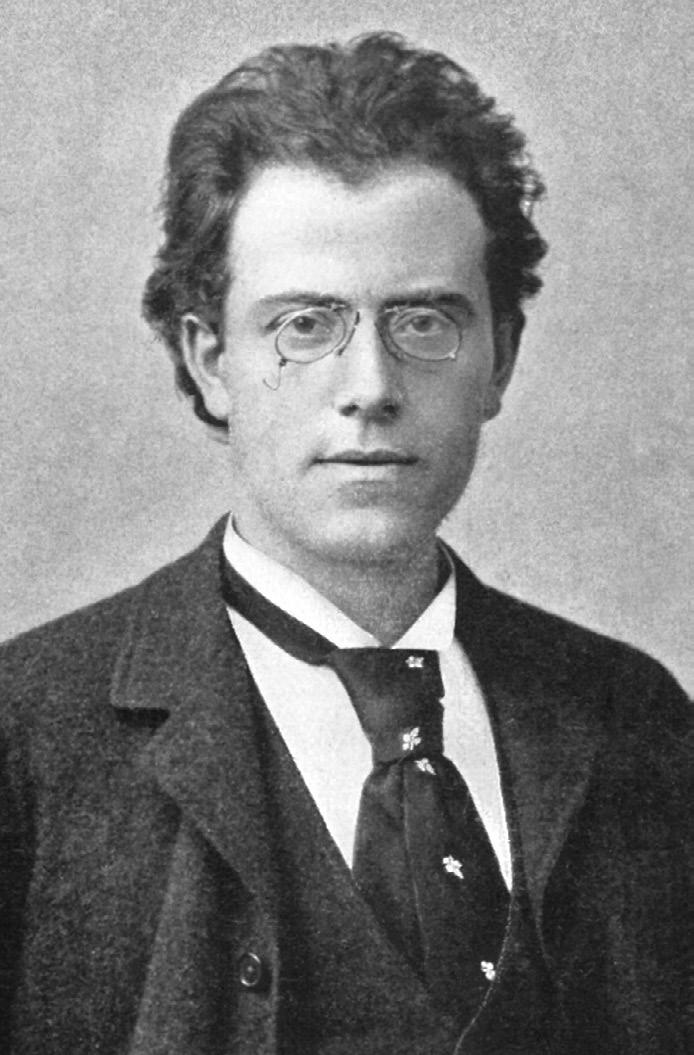
This instance aside, Mahler’s symphonies were generally not well received in his lifetime and were met with confusion. It was only a handful of conductors such as Walter, Klemperer and Mengelberg who carried the torch in the early 20th century, before others like Stokowski, Mitropoulos, Barbirolli and, notably, Bernstein, pushed Mahler’s music into the mainstream in Europe and America in the 1950s. Since then, Mahler has become one of the most performed and recorded composers.
The Second Symphony was conceived following a rather peculiar incident. On the night of 20th January 1888, Mahler returned home after conducting Weber’s comic opera Die drei Pintos. With the wreaths he received after the performance, he arranged flowers and candles around his bed, laid down in the middle, and imagined himself to be in a coffin at his own funeral.
This bizarre act spurred Mahler to begin drafting the first movement, an extensive funeral march that he titled Totenfeier (“Funeral Rites”). Thus began an arduous six-year journey from 1888 to 1894 to bring the symphony to completion, during which Mahler faced interruptions due to his hectic conducting schedule and a lack of creative inspiration – notably revived upon hearing Klopstock’s Resurrection Ode at conductor Hans von Bülow’s funeral, which formed the basis of the finale.
The first movement opens with an angry onslaught driven by the lower strings. It gradually grows into a steady funeral march. Mahler describes: “we stand at the funeral of a well-loved person. His struggles, passions and aspirations come to mind… in this moment of emotion, we ask: what now? Do we exist after death? Is life only a confused dream, or is there a meaning to it all?” Several possible answers are whispered — the hope of eternal life after death is briefly suggested, as is the “calm of the sea” breathed by the flute. These are however no match for the grinding, brutal force of dark despair which extinguishes all hope, keeping the movement grimly rooted to the ground.
After a pause, a breath of fresh air wafts in as the second movement brings a Ländler, an Austrian folk dance, to the forefront. It is in this pastoral landscape where “a ray of pure sunlight illuminates a happy moment from the departed person’s life”, as well as the wistful, sombre ones. Melancholic moments depict a “sad recollection of his youth and lost innocence”.
Two strikes of the timpani unleash the third movement, bringing on a sinister and sarcastic whirl of notes as we “awaken from that melancholic dream and are forced to return
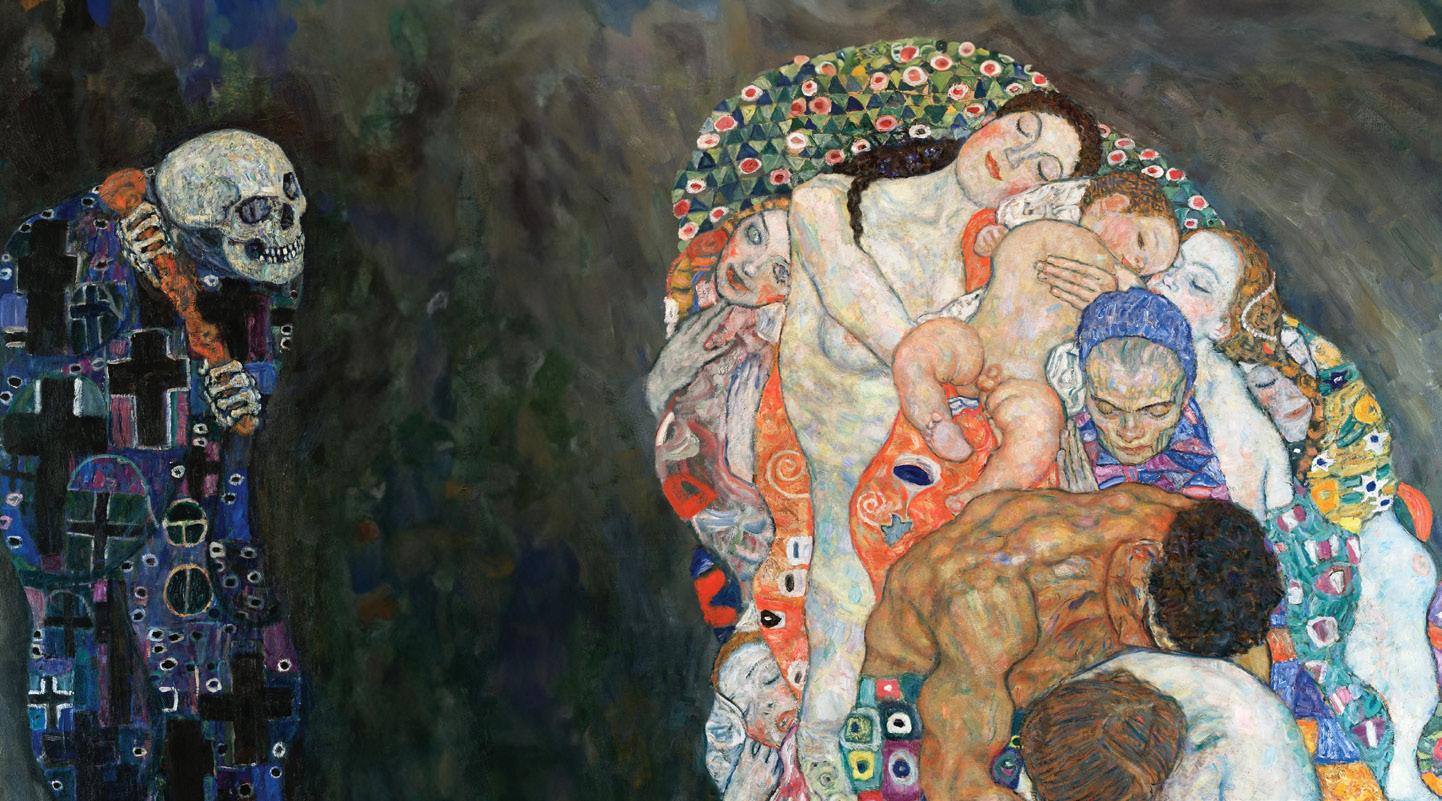
to this tangled life of ours.” Here, Mahler observes the ceaseless and meaningless motion of the daily grind as an outsider –“watching a dance through a window and hearing no music; the turning and twisting seems senseless. The world looks like this when you lose yourself, distorted and crazy, as if reflected in a concave mirror… the tortured soul cries out in despair.” This abruptly slips into silence and is replaced by a new sound — the sound of a human voice.
The fourth movement provides an oasis with the setting of the poem, Urlicht (“Primal Light”). Mahler writes, “Poised as if on the edge of a great chasm the moving voice of simple faith sounds in our ears and draws us back from the darkness of oblivion...The struggle of the human soul for God ... comes to the forefront.” This interlude ends beautifully, lingering upon the word Leben (“Life”).
A return of the “Cry of Despair” brings us to the fifth movement, as the brass opens up the “Fright Fanfare”. We are thrust from
the more personal perspective of the earlier movements into that of the epic. Mahler ushers in the Apocalypse — the end of the world according to the Christian faith, complete with the destruction of the world and second resurrection of the saints.
A sudden stillness takes over, and distant horn calls lead us into the movement proper. A great percussion crescendo, representing an earthquake, leads us to an apocalyptic march. It builds to an overwhelmingly dark climax as “the graves spring open, and all of creation comes writhing out … marching along in a mighty procession: beggars and rich men, common folk and kings. All terrified, for none are just in the sight of God.”
Fanfares from another world interrupt the frightened and pleading men, all building up to the return of the dreadful “Cry of Despair”. Suddenly, all is calm as we enter the eternal realm. Back on earth, the last calls of the Bird of Death trill and fade away – the “last quivering echo of earthly life.”
Silence falls, and in that calm, the chorus is heard alone, intoning the Resurrection hymn. Solo voices break free and soar with Mahler’s words, laying all previous existential doubts to rest: “Oh believe! Thou were not born in vain! Hast not lived in vain, suffered in vain!” An almost spiritual certainty takes hold, with the
chorus, orchestra and organ blazing forth. The journey is brought to an exhilarating and glorious climax over the words, “what you have struggled for shall carry you to God!”
“An overwhelming love lightens our being. We know and are.”
In addition to his symphonies, Mahler also wrote many sets of songs, including the famous Des Knaben Wunderhorn (“The Boy’s Magic Horn”) – a collection of 12 songs based on German folk poems, broadly centred around the nostalgic yearning after lost innocence.
Mahler utilised several of these songs as the basis for entire movements in his Second, Third, and Fourth Symphonies, leading to them being given the nickname the “Wunderhorn Symphonies”. The most obvious example in his Second Symphony is the direct incorporation of Urlicht in the fourth movement, albeit slightly expanded.
To underpin the ceaseless whirl of notes depicting the senselessness of life in the third movement, Mahler quotes the song, Des Antonius von Padua Fischpredigt (“St. Anthony of Padua’s Sermon to the Fish”). In this song, St. Anthony preaches to the fishes, who after being admonished by the saint on their thoughtless lives, swim off just as before. The movement works well without knowing the song, but for listeners who know this additional context, it provides an additional depth to the movement’s message of futile labour.
Besides Wunderhorn songs, Mahler also quoted from common and popular tunes to create additional layers of meaning and understanding across his symphonies. Maestro Hans Graf pointed out to us that in the middle of the great march of the dead in the last movement, a German Christmas song, Oh du fröhliche oh du selige Gnadenbringende Weihnachtszeit (“Oh you joyful, blessed, Grace-bringing Christmastime”), emerges. In particular, the tune to these verses is quoted almost exactly by the brasses: Welt ging verloren, Christ ist geboren: Freue, freue dich, o Christenheit! (“The world was lost, Christ is born: Rejoice, rejoice, O Christendom!”). It must have been absolutely startling for the German audience members at the premiere to have this fragment waft in and be caught up in the thunderous climax, before an eternal calmness takes over...
Urlicht
O Röschen rot!
Der Mensch liegt in grösster Not!
Der Mensch liegt in grösster Pein!
Je lieber möcht’ ich im Himmel sein!
Da kam ich auf einen breiten Weg; Da kam ein Engelein und wollt’ mich abweisen.
Ach nein! Ich liess mich nicht abweisen!
Ich bin von Gott und will wieder zu Gott!
Der liebe Gott wird mir ein Lichtchen geben, Wird leuchten mir bis in das ewig selig Leben!
— from Des Knaben Wunderhorn (“The Boy’s Magic Horn”)
Primal Light
O little red rose!
Humankind lies in greatest need!
Humankind lies in greatest pain! Much rather would I be in Heaven!
Then I came onto a broad path; And an angel came and wanted to turn me away.
But no, I would not be turned away! I am from God and would return to God!
The dear God will give me a little light, Will light me to eternal, blissful life!
Instrumentation
solo voices, 4 flutes (all doubling on piccolos), 4 oboes (2 doubling on cor anglais), 4 clarinets (1 doubling on bass clarinet, 1 doubling on E-flat clarinet), E-flat clarinet, 4 bassoons (2 doubling on contrabassoon), 10 horns (with 4 doubling off-stage), 6 trumpets (with 2 doubling off-stage), 2 off-stage trumpets, 4 trombones, tuba, 2 timpani (plus 1 offstage), glockenspiel, bells, triangle, cymbals, suspended cymbal, rute, tam-tam, snare drum, bass drum, 2 harps, organ, strings
World Premiere 13 Dec 1895, Berlin
First performed by SSO 6 Jun 1994
Aufersteh’n, ja aufersteh’n wirst du, Mein Staub, nach kurzer Ruh!
Unsterblich Leben! Unsterblich Leben Wird, der dich rief, dir geben.
Wieder aufzublüh’n, wirst du gesät!
Der Herr der Ernte geht
Und sammelt Garben
Uns ein, die starben.
— Friedrich Gottlieb Klopstock
O glaube, mein Herz, o glaube:
Es geht dir nichts verloren!
Dein ist, ja Dein, was du gesehnt, Dein, was du geliebt, Was du gestritten!
O glaube:
Du wardt nicht umsonst geboren!
Hast nicht umsonst gelebt, gelitten!
Was entstanden ist, das muss vergehen!
Was vergangen, auferstehen!
Hör’ auf zu beben!
Bereite dich zu leben!
O Schmerz! Du Alldurchdringer!
Dir bin ich entrungen!
O Tod! Du Allbezwinger! Nun bist du bezwungen!
Mit Flügeln, die ich mir errungen, In heissem Liebesstreben Werd’ ich entschweben
Zum Licht, zu dem kein Aug’ gedrungen! Sterben werd’ ich, um zu leben!
Aufersteh’n, ja aufersteh’n wirst du, Mein Herz, in einem Nu!
Was du geschlagen, Zu Gott wird es dich tragen!
— Gustav Mahler
Rise again, yes, you will rise again, My dust, after brief rest!
Immortal life! Immortal life Will He, who called you, grant you.
To bloom again, you were sown! The Lord of the Harvest goes And gathers sheaves, Us, who died.
O believe, my heart, believe: Nothing will be lost to you! Yours, yes, yours is what you longed for, Yours what you loved, What you fought for!
O believe:
You were not born in vain! You have not lived in vain, nor suffered!
All that has come into being must perish!
All that has perished must rise again! Cease from trembling! Prepare to live!
O Pain, piercer of all things!
From you I have been wrested!
O Death, conqueror of all things! Now you are conquered!
With wings I won for myself, In love’s ardent struggle, I shall fly upwards
To that light which no eye has ever seen! I shall die so as to live!
Rise again, yes, you will rise again, My heart, in the twinkling of an eye! What you have conquered, Will bear you to God!
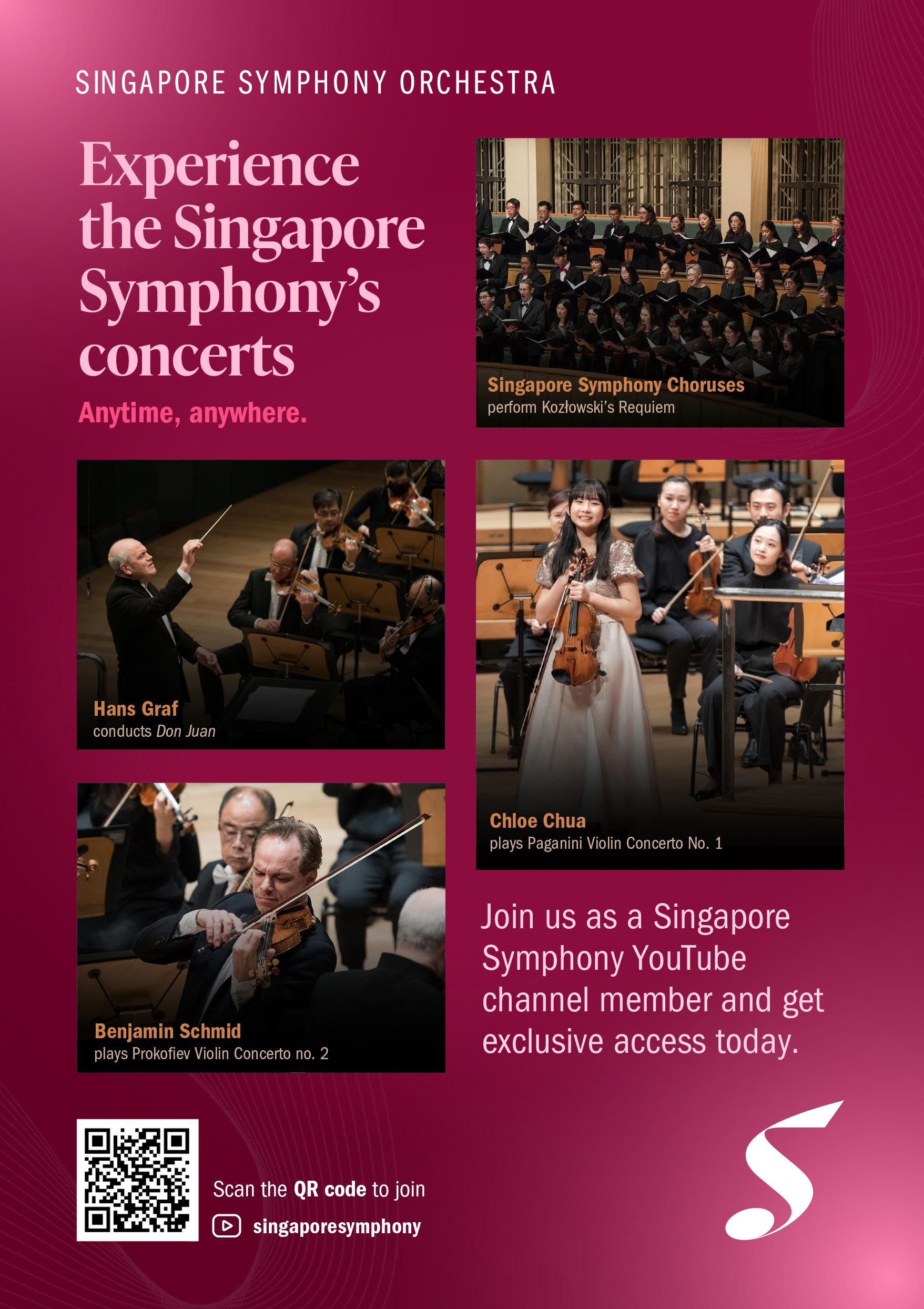
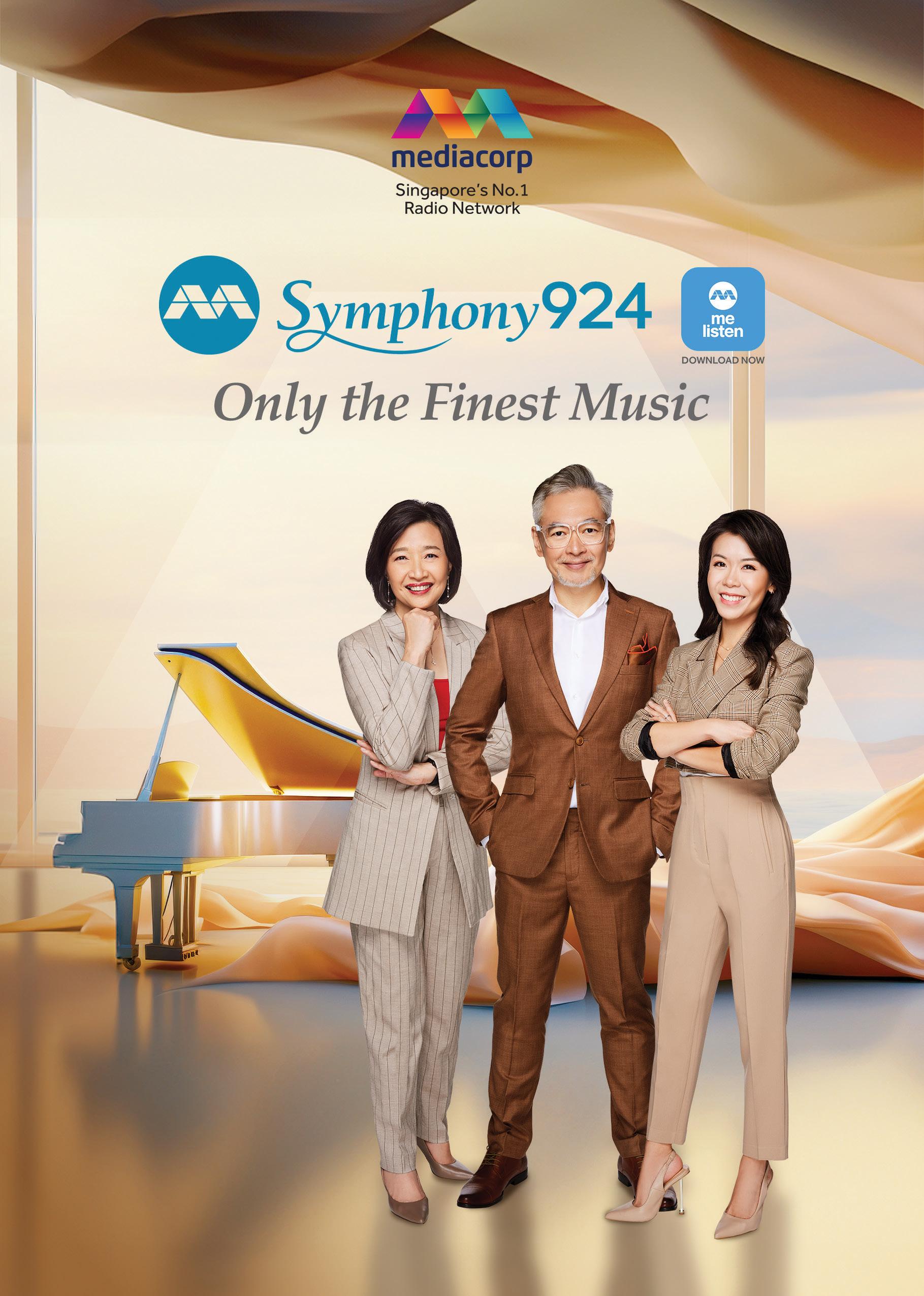
We would like to express our deepest appreciation to the following individuals and organisations who support our mission to create memorable shared experiences with music in the past year. Without your support, it would be impossible for the SSO to continue to strive for artistic excellence and touch the hearts of audiences.
PATRON SPONSOR
Tote Board Group
(Tote Board, Singapore Pools & Singapore Turf Club)
MAESTRO CIRCLE
Mr & Mrs Goh Yew Lin
Stephen Riady Group of Foundations
Temasek Foundation
The HEAD Foundation
Anonymous (1)
CONCERTMASTER CIRCLE
DBS Bank Ltd
Paige Parker & Jim Rogers
S YMPHONY CIRCLE
Geraldine Choong & Dennis Au
De Miguel Solaguren Family
Far East Organization
Dr & Mrs Antoine & Christina Firmenich
Khoo Boon Hui
Lee Li Ming
Mind the Gap 200 Fund
Jacqueline Yeh
Yong Hon Kong Foundation
Anonymous (3)
CONCERTO CIRCLE
Prof Chan Heng Chee
Cara & Tamara Chang
Madeleine Cheok & Wong Hong Ching
Elaine and Eduardo Saverin Foundation Ltd
Embassy of France in Singapore
Christopher Fussner
Dr Geh Min
IMC Group Asia (S’pore) Pte Ltd
Kris Foundation
Kenneth Kwok
LGT Bank (Singapore) Ltd
Frans & Marie-Pierre Mol
MTM Skincare Pte Ltd
Neo Group Limited
Mr & Mrs Ong Kok Chye
Patek Philippe Southeast Asia
Priscylla Shaw
Andreas & Doris Sohmen-Pao
Tower Capital Asia
Dr Edwin Tan
UOB
Geoffrey & Ai Ai Wong
Yong Ying-I
Dr Thomas & Mrs Mary Zuellig


OVERTURE PATR ONS
Odile & Douglas Benjamin
Lito & Kim Camacho
Cavazos Tinajero Family
Prof Cham Tao Soon
Alan Chan
Vivian Chandran
Chen Xiaoyan
Daniel Choo & Family
Chopard (Asia) Pte Ltd
Dr & Mrs Choy Khai Meng
Clarence Chua
Energeo Systems Pte Ltd
Karen Fawcett & Alisdair Ferrie
FRED Jewelry
Goh Swee Chen
Guy Hentsch & Geoffrey Yu
Miriam & Merle Hinrich
Rathi Ho & Dorian Goh
Holywell Foundation
Hong Leong Foundation
Illumia Medical Pte Ltd
Vanessa & Darren Iloste
JCCI Singapore Foundation
Vivian Kao & Shou Zi Chew
Jeffrey Khoo
Dr & Mrs Adrian Koh
Krishnan Family
Chloe Lee & Family
Colin & Janet Leong
Leong Wai Leng
Tommy Leung & Karen Er
Mavis Lim Geck Chin
Marina Bay Sands
Devika & Sanjiv Misra
NEON Global
Paul & Lena Ng
NSL LTD
PCS Pte Ltd
Poh Khim Hong
Farhana Sharmeen
Prof Gralf & Silvia Sieghold
Sirivadhanabhakdi
Joy & Han Li Toh
Tan Meng Cheng Ivan
V3 Wellness Pte Ltd
Watson Farley & Williams LLP
Xu Ren
Kevin T Yap
Grace Yeh
Zeng Fuzu
Zeng Liqing
Anonymous (6)
Marcelo V Achoa & Silvia Bordoni
Michael RPM Brenninkmeijer
Julian & Sandra Chang
Embassy of the Kingdom of Spain
John & Pauline Foo
Goh Hui Kok Michael
Liwen & Steven Holmes
Rebecca Hong
Shawn (See Hyung) Jeon
Katherine Kennedy-White
Wayne & Kim Giap Khoo
Maisy Koh
Lorinne Kon
Lai Siu Chiu
Paterson Lau & Pauline Tan
Madeleine Lee
Lee Ming San
Lee Shu Yen
Adeline Ang
Brenda Ang
ACE Team Foundation
Lawrence & Celeste Basapa
Bloomberg Singapore Pte Ltd
Julien Brousseau
Cheng Eng Aun
Dr Chew Chee Tong
Faith Chia
Evelyn Chin
Pierre Colignon
Arnoud De Meyer
Natalia Galinovskaya
Gin & Doug
Jerry Gwee
Hoon Chew & Jennifer
Hwang Chih Ming
Arjun Jolly & Priyanka Nayar
Belinda Koh
Winston & Valerie Kwek
Lee Hyunsun
SC & WY Leong
Anna Liang Yao & Li Jingyi
Caroline Lim
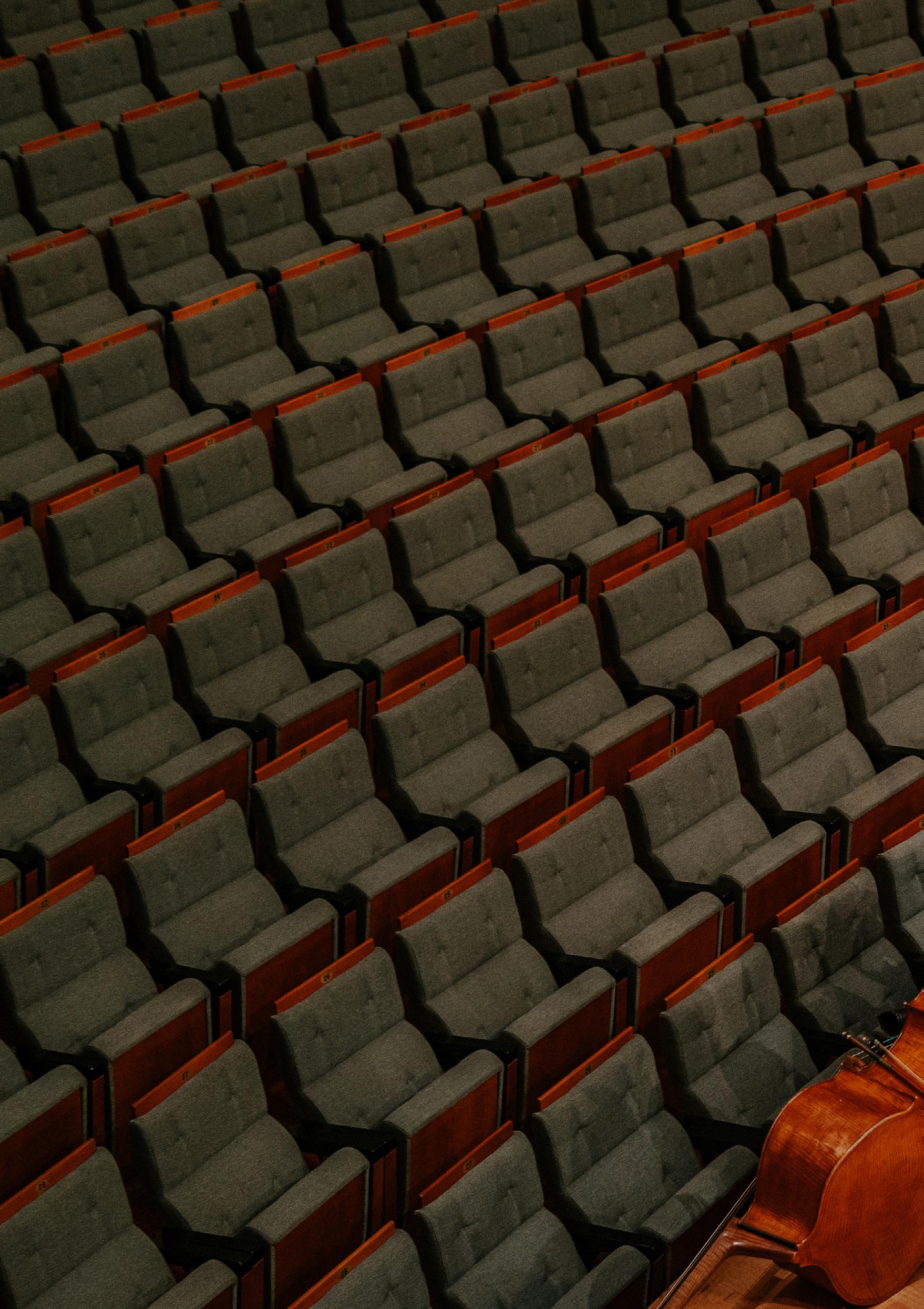
Lee Yeow Wee David
Leong Wah Kheong
Darren Lim & En Yu Tan
The Linh Tinh Family
Jin Lu
Joanna Ludkiewicz & Robert Hunziker
Kishore & Anne Mahbubani
Francoise Mei
Meng
Ong Kong Hong
Dr June & Peter Sheren
Eugene Sng
The Sohn Yong Family
Tan Seow Yen
Tan Wan Chi
G L Wee
Chuin Wei Yap
Anonymous (4)
Kok Leong Lim
Suzanne Lim
Dr Victor Lim
Jesher Loi
Benjamin Ma
Prof Tamas Makany & Julie Schiller
msm-productions
Debra Ng
Kenneth Oo
Ian & Freda Rickword
Charles Robertson
Audrey Ruyters
Marcel Smit & Hanneke Verbeek
Julian Tan
Aileen Tang
Tang See Chim
Anthony Tay
Benedict Teo
Kris Wiluan
Eric Wong
Wong Yan Lei Grace
Jenny Zhu Huimin
Anonymous (6)
A.R.
Hyder Ahmad
Pauline Ang
Ang Seow Long
Tatiana Antonova & Stanislav Miroshnichenko
Virna Machado & Ashish Goyal
Min Tan
Herman Felani MY
Hans Michael Brandes
John Cai
Bryan Carmichael
Chan Ah Khim
Pauline Chan
Chang Chee Pey
Yuna Chang
Jeanie Cheah
Cynthia Chee
Dr Christopher Chen
YC Chen
Cheng Sok Theng
Anthony Chng
Choi Yuet Yuen
Chong Mi-Li Pamela
Ruby Chong
Tiffany Choong & Shang Thong Kai
Chor Siew Chun
Clarissa Chow
Jennie Chua
Chua Yeow Kiang
CP
Dr Rebecca Dent & Dr Greg Jakubowski
Maggie Dong
Jamie Lloyd Evans
J-P & Colette Felenbok
Claudia & Henning Figge
Dr Foo Swee Sen
Soumyadip Ghosh
Goh Chiu Gak
Keith Goh
Mrs Goh Keng Hoong
Prof Goh Suat Hong
Gonsalves Gavin Jason Marshall
Gu Zhenhao
Parthesh Gulawani
Winston Hauw
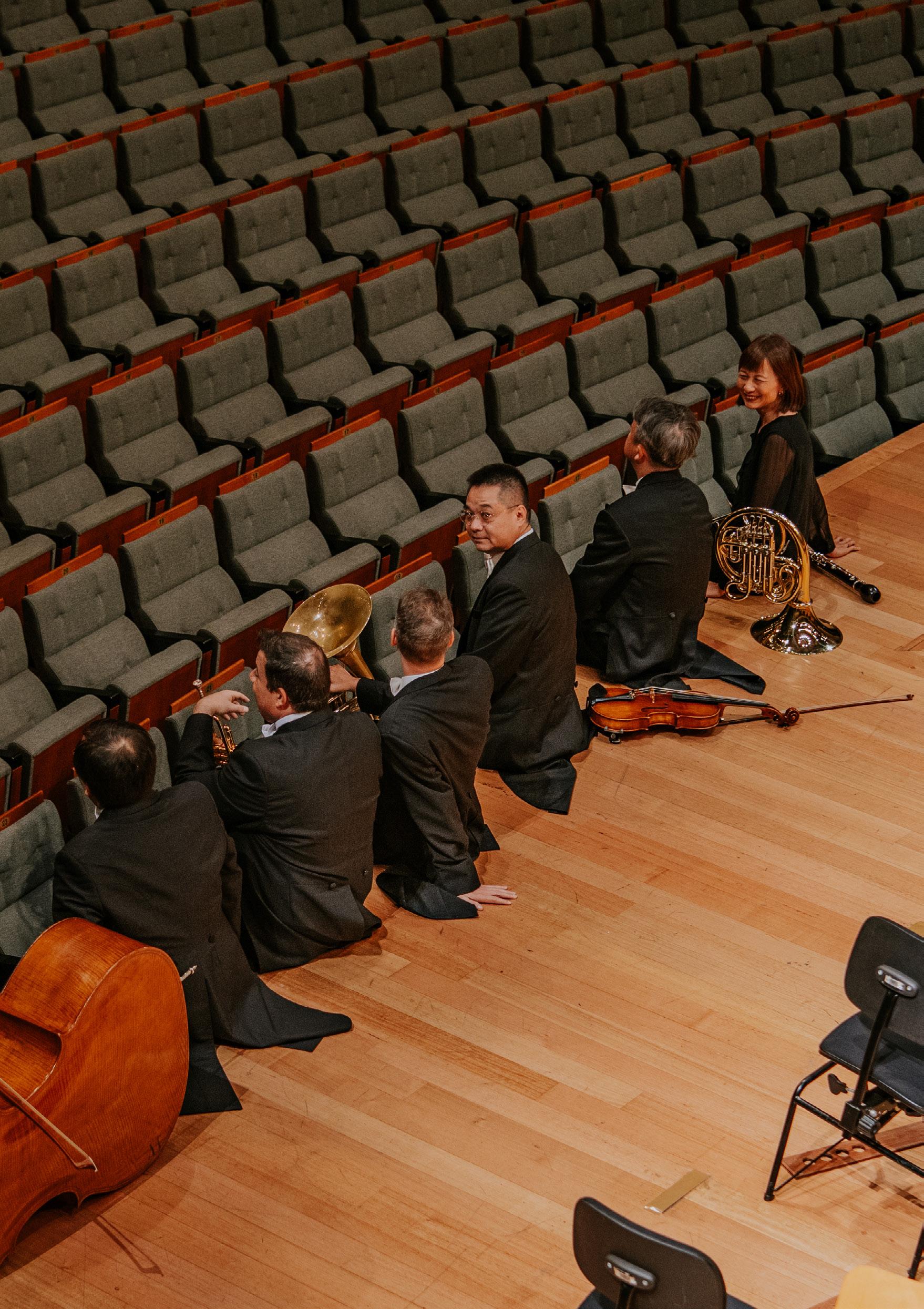
Terence Heng
Henry & Tiffany
Ho Jun Yi
Kelvin Ho
Eunice Huang
Claire & Ian Jones
K Goh Family
Ernest Khoo Khor Cheng Kian
Koh Siew Yen Terri
Colin Lang
Lau Soo Lui
Dr & Mrs Winson Lay
Jeanne Lee
Dr Norman Lee
Sonja & Viktor Leendertz
Churen Li
Li Danqi & Liu Yi
Xiao Li
Joanne Lim
Debby Lim
Edith & Sean Lim
Derek Lim
Lim Yuin Wen
Low Boon Hon
Lily Low
Samantha Low Wei Ting
Loy Suan Mao, Alwyn
Fabian Lua
Dr Elaine Lum
April Mak
Andre Maniam
Claire MC
McCann Family
Minwei
Dex & Mint
Nurture With Love Suzuki Music School
Ghislain Olagne
Ong Chee Siong
Xinyi Ong
Victor Ow
Phua Ching Shyen
Pigar & William
Michael & Katherin Puhaindran
Ang Quek Kaifeng
Suranga Rajapakse
Arkady Raynes
Robert Khan & Co Pte Ltd
Kadir Satar
Janek Schergen
Soh Leng Wan
Yook Lin Soo
Ronald & Janet Stride
Andrew & Jacqueline Tan
Casey Tan Khai Hee
Christine Tan & Jeremy Ting
Jean Tan
Tan Kok Huan
Michelle Tan
Dr Giles Tan Ming Yee
Dr Pamela Tan
Tan Peng Peng
Yee Deng Tan
Tay Kim Ann
Teo Eng Chai
Dr Teo Kien Boon
Kyra Teo
Teo Wee Poh
Alicia Thian & Brian Bonde
Yang Tian
Sandra Tsao
Naserah Tyebally
Wang Lei & Gao Bo
Wang Pei Zhong
Tania Wee
Dr Wong Hin Yan
Wicky Wong
Jennifer S Wu
Elaine Xu
Yan Xia
Hans Yeh
Yeo Su Inn
Yong Chuk Kwin
Daniel Yong
Yong Seow Kin
Zhang Zheng
Zhu Yulin Anonymous (41)
This list reflects donations that were made from 1 Apr 2024 to 31 Mar 2025. We would like to express our sincere thanks to donors whose names were inadvertently left out at print time. The Singapore Symphony Group is a charity and a not-for-profit organisation. Singapore tax-payers may qualify for 250% tax deduction for donations made. You can support us by donating at www.sso.org.sg/donate or www.giving.sg/sso.
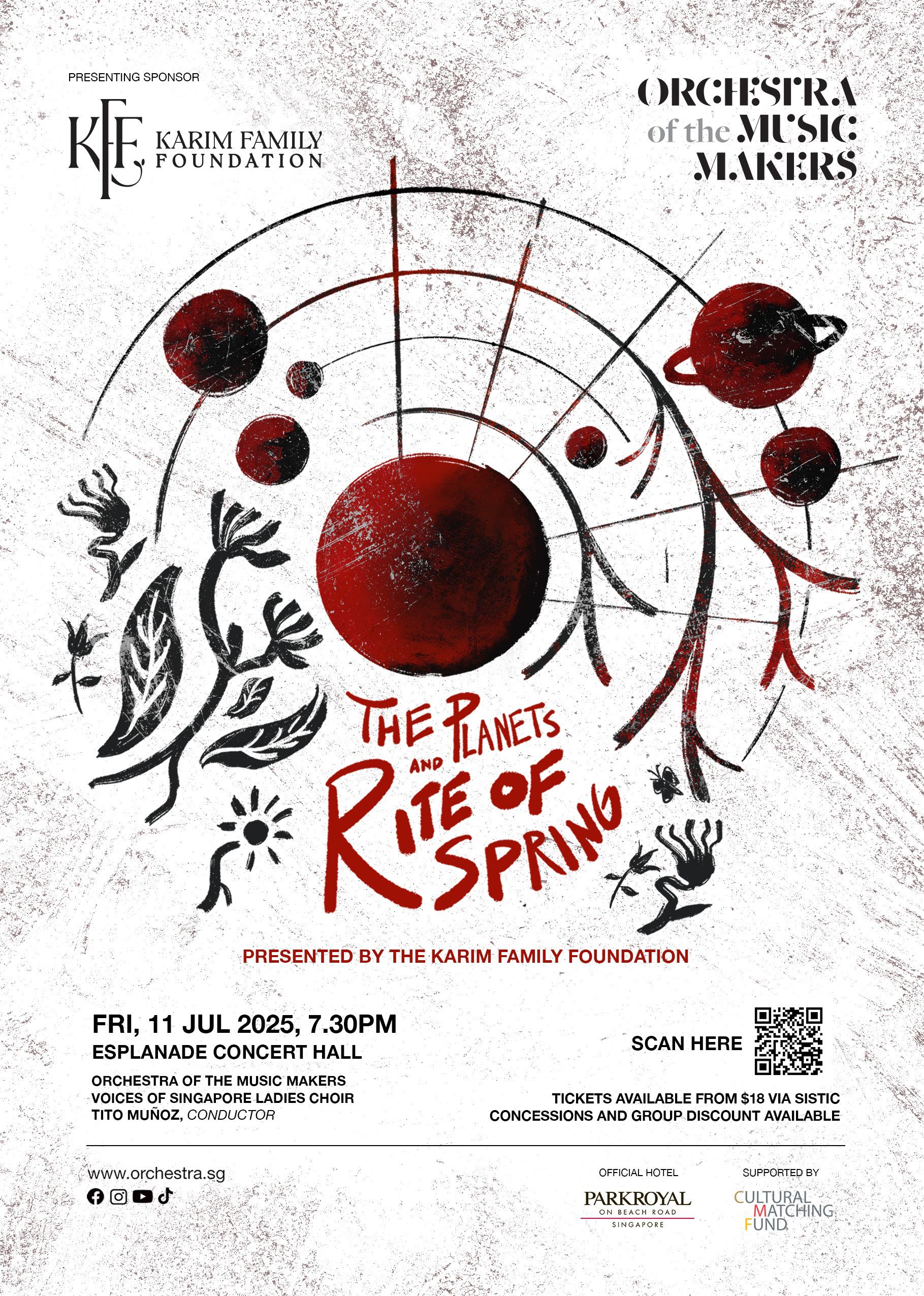
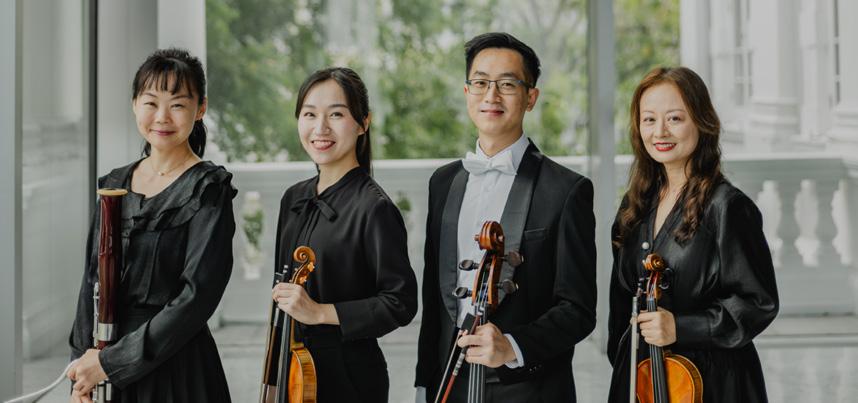
While SSO is supported partially by funding from the Singapore government, a significant part can only be unlocked as matching grants when we receive donations from the public. If you are in a position to do so, please consider making a donation to support your orchestra – Build the future by giving in the present.
As a valued patron of the SSO, you will receive many benefits. How
We provide our Corporate Patrons with impressive entertainment and significant branding opportunities. Through our tailored packages, corporates may benefit from:
• Publicity and hospitality opportunities at an SSO concert or your private event,
• Acknowledgement and mentions in SSO’s key publicity channels,
• National Arts Council (NAC) Patron of the Arts nominations,
• Tax benefits.
Packages start at $10,000 and can be tailored to your company’s branding needs.
We partner with various corporates through tailored in-kind sponsorship and exchange of services. Current and recent partnerships include Official Hotel, Official Airline, and we offer other exciting titles.
For more details, please write to Sarah Wee at sarah.wee@sso.org.sg
We recognise major gifts that help sustain the future of the Singapore Symphony Group. The recognition includes naming of a position in the SSO or in our affiliated performance groups such as the Singapore National Youth Orchestra and the Singapore Symphony Choruses.
F or more information, please write to Chelsea Zhao at chelsea.zhao@sso.org.sg.
SSO Concertmaster l GK Goh Chair
In July 2017, the SSO established the GK Goh Chair for the Concertmaster. Mr Goh Geok Khim and his family have been long-time supporters of the national orchestra. We are grateful for the donations from his family and friends towards this Chair, especially Mr and Mrs Goh Yew Lin for their most generous contribution.
Mr Igor Yuzefovich was the inaugural GK Goh Concertmaster Chair. The position is currently vacant.
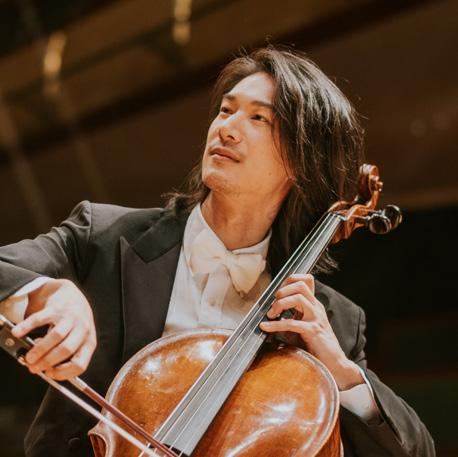
SSO Principal Cello
The Head Foundation Chair
In recognition of a generous gift from The HEAD Foundation, we announced the naming of our Principal Cello, “The HEAD Foundation Chair” in November 2019. The Chair is currently held by Principal Cellist Ng Pei-Sian.
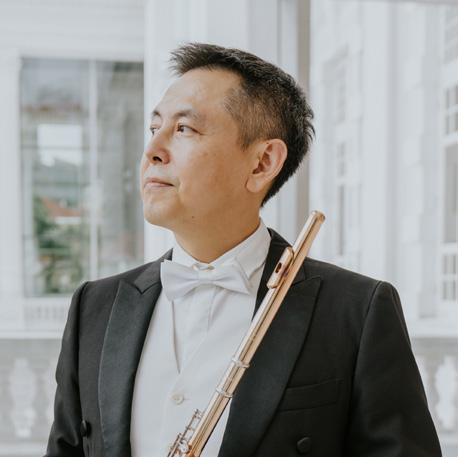
SSO Principal Flute
Stephen Riady Chair
In recognition of a generous gift from Dr Stephen Riady, we announced in May 2022 the naming of our Principal Flute, “Stephen Riady Chair”. The position is currently held by our Principal Flutist Jin Ta.
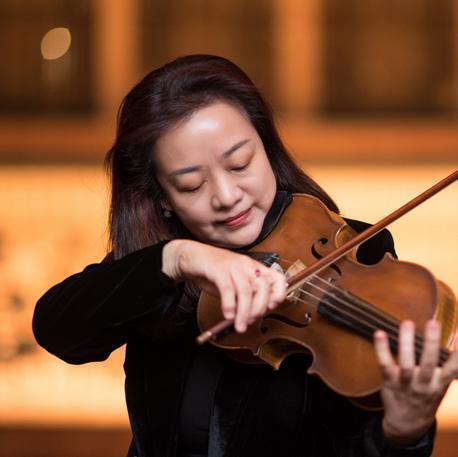
SSO Principal Viola
Tan Jiew Cheng Chair
In recognition of a generous gift from the Estate of Tan Jiew Cheng, we announced in February 2024 the naming of our Principal Viola, “Tan Jiew Cheng Chair”. The position is currently held by our Principal Violist Manchin Zhang.
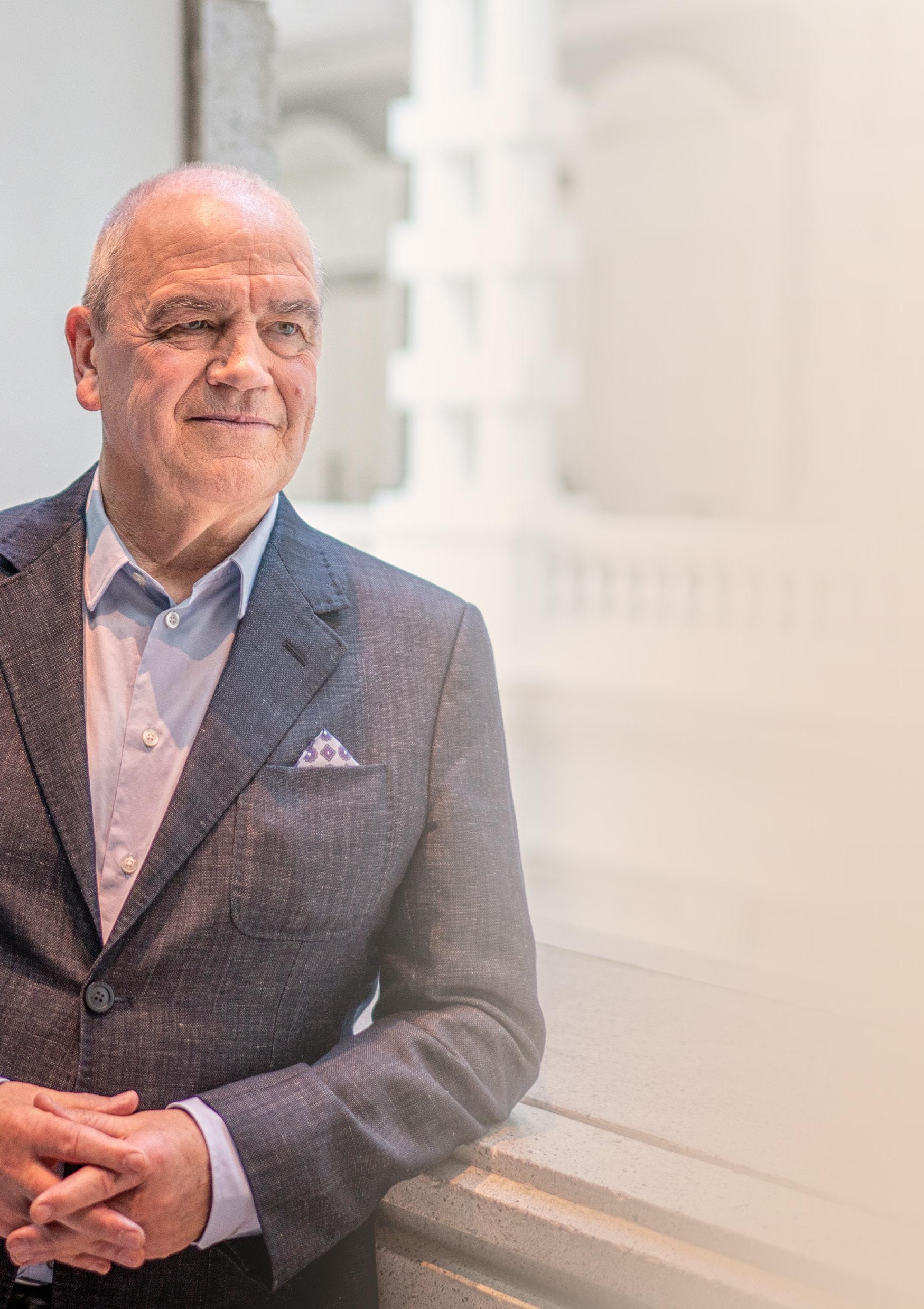
The SSO is delighted to announce the naming of the “Quantedge Music Director” position, currently held by Maestro Hans Graf.
With his spirit of musical exploration, innovative programming, and captivating stage presence, Maestro Graf has consistently inspired audiences and elevated orchestras to new heights. We are deeply grateful for his continued leadership as Chief Conductor in the 2020/21 season and Music Director since the 2022/23 season.
We extend our sincerest gratitude to our anonymous donor for this generous gift of $3 million to mark SG60.



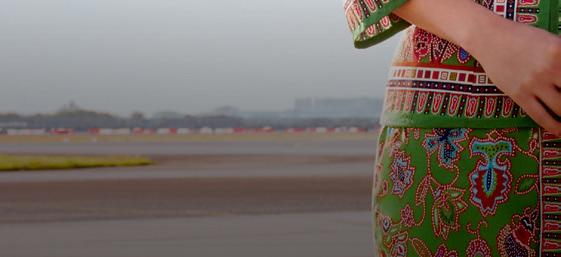

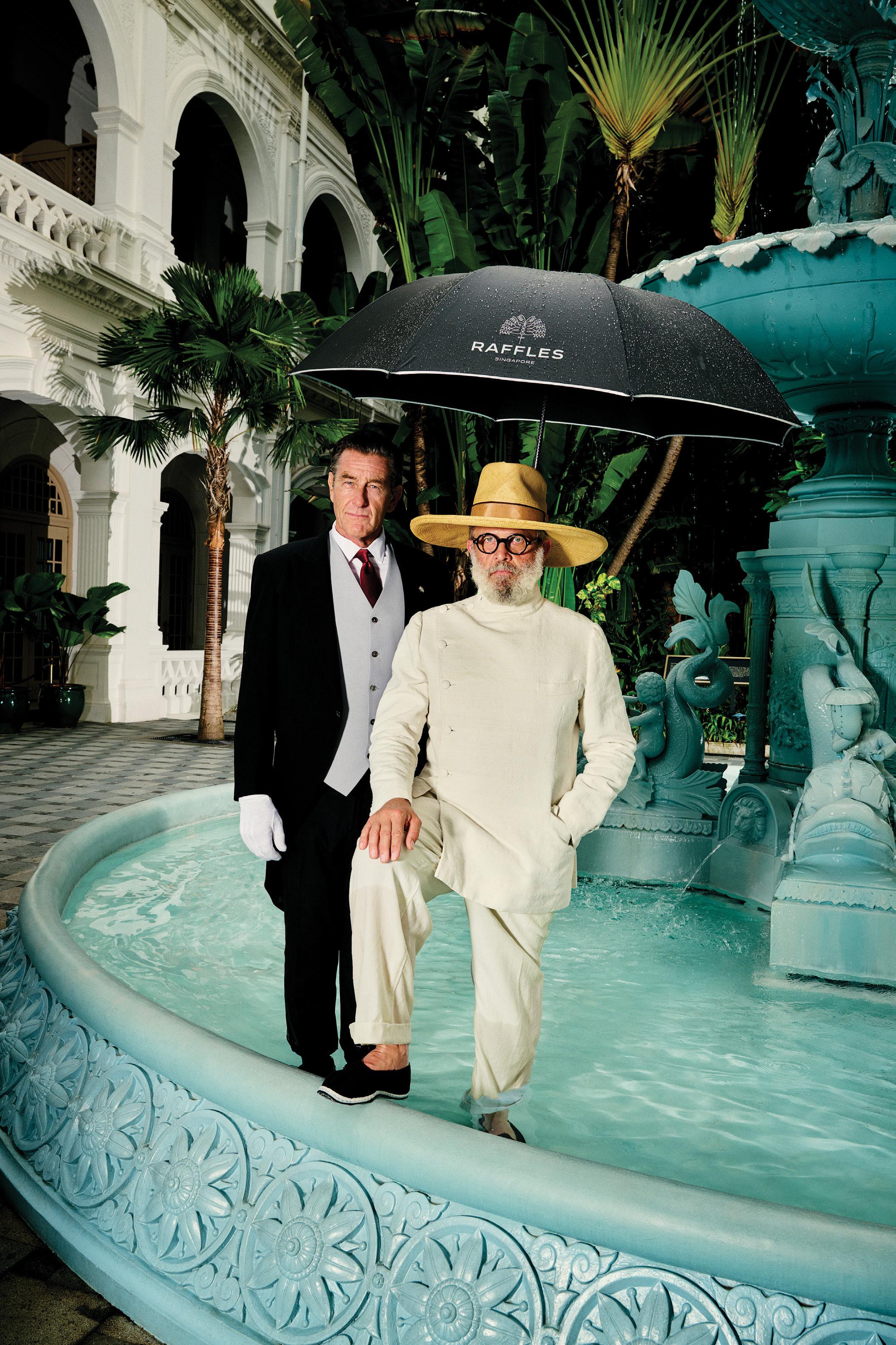
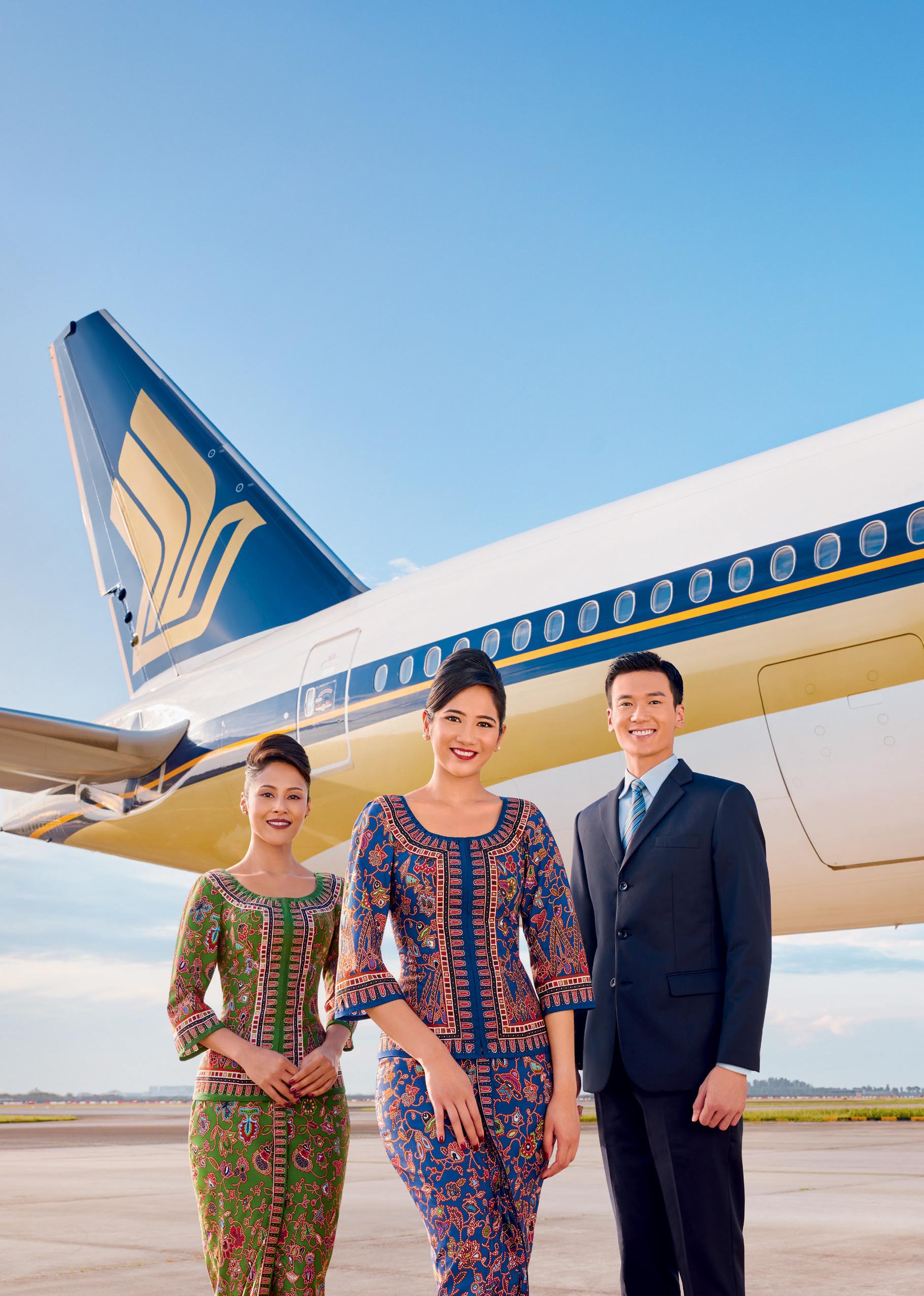




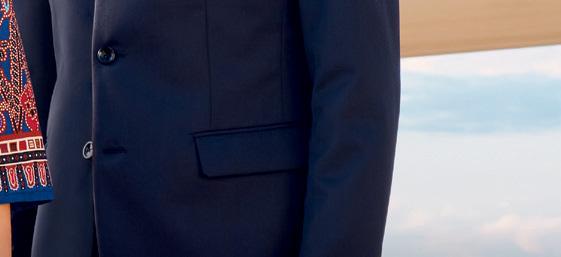
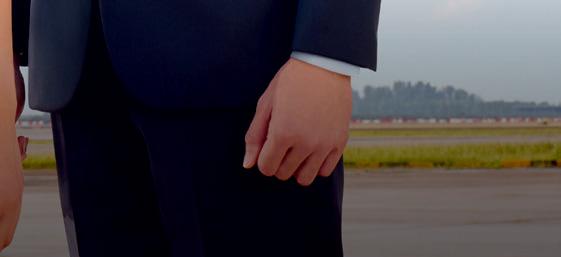

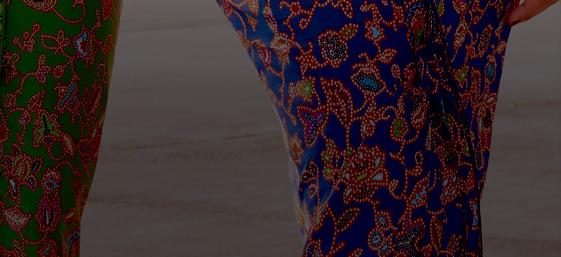
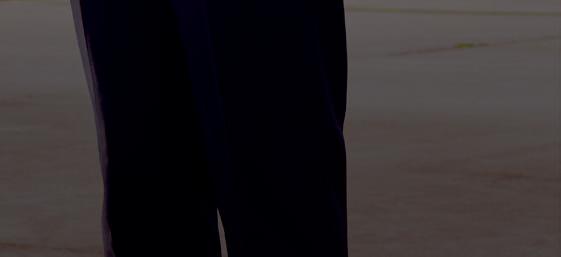


Chair
Goh Yew Lin
Board of Directors
Chang Chee Pey
Chng Kai Fong
Andress Goh
Kenneth Kwok
Clara Lim-Tan
Jesher Loi
Lynette Pang
Prof Qin Li-Wei
Jovi Seet
Farhana Sharmeen
Doris Sohmen-Pao
Prof Peter Tornquist
Geoffrey Wong
Andrew Yeo Khirn Hin
EXECUTIVE & NOMINATING COMMITTEE
Goh Yew Lin (Chair)
Chng Kai Fong
Lynette Pang
Geoffrey Wong
HUMAN RESOURCES COMMITTEE
Doris Sohmen-Pao (Chair)
Jesher Loi
Prof Qin Li-Wei
Heinrich Grafe*
Carmen Wee*
FINANCE & INVESTMENT COMMITTEE
Geoffrey Wong (Chair)
Andress Goh
Chua Keng Hong*
Alex Lee*
AUDIT & RISK COMMITTEE
Jovi Seet (Chair)
Prof Peter Tornquist
Andrew Yeo Khirn Hin
Ryan Siek*
COMMUNITY & YOUTH E NGAGEMENT COMMITTEE
Clara Lim-Tan (Chair)
Chang Chee Pey
Farhana Sharmeen
Asst Prof Kat Agres*
Cecilia Pang*
SSO Musicians' Committee
Mario Choo
David Smith
Wang Xu
Christoph Wichert
Yang Zheng Yi
Elaine Yeo
Zhao Tian
SSO Council
Alan Chan (Chair)
Odile Benjamin
Prof Chan Heng Chee
Prof Arnoud De Meyer
Dr Geh Min
Heinrich Grafe
Khoo Boon Hui
Liew Wei Li
Lim Mei
Sanjiv Misra
Paige Parker
Dr Stephen Riady
Priscylla Shaw
Prof Gralf Sieghold
Prof Bernard Tan
Dr Tan Chin Nam
Wee Ee Cheong
Yong Ying-I
*co-opted member
Chief Executive Officer
Kenneth Kwok
Deputy CEO
Programmes & Production
Kok Tse Wei
CEO OFFICE
Shirin Foo
Musriah Bte Md Salleh
ORGANISATION DEVELOPMENT
Lillian Yin
A rtistic Planning
Hans Sørensen (Head)
Christopher Cheong
A RTISTIC ADMINISTRATION
Jodie Chiang
Terrence Wong
Jocelyn Cheng
Michelle Yeo
Operations
Ernest Khoo (Head)
L IBRARY
Wong Yi Wen
Cheng Yee Ki
ORCHESTRA MANAGEMENT
Chia Jit Min (Head)
Charis Peck Xin Hui
Kelvin Chua
P RODUCTION MANAGEMENT
Noraihan Bte Nordin
Nazem Redzuan
Leong Shan Yi
Asyiq Iqmal
Khairi Edzhairee
Khairul Nizam
Benjamin Chiau
DIGITAL PRODUCTION
Avik Chari
Deputy CEO
Patrons & Corporate Services
Jenny Ang
C OMMUNITY ENGAGEMENT
Kua Li Leng (Head)
Samantha Lim
Whitney Tan
Lynnette Chng
C HORAL PROGRAMMES
Kua Li Leng (Head)
Lu Heng
Chang Hai Wen
Mimi Syaahira
SINGAPORE NATIONAL
YOUTH ORCHESTRA
Ramu Thiruyanam (Head)
Tang Ya Yun
Tan Sing Yee
Ridha Ridza
ABRSM
Patricia Yee
Lai Li-Yng
Joong Siow Chong
Freddie Loh
May Looi
Corporate Services
F INANCE, IT & FACILITIES
Rick Ong (Head)
Alan Ong
Goh Hoey Fen
Loh Chin Huat
Md Zailani Bin Md Said
HUMAN RESOURCES & ADMINISTRATION
Valeria Tan (Head)
Janice Yeo
Fionn Tan
Netty Diyanah Bte Osman
DEVELOPMENT
Chelsea Zhao (Head)
Nikki Chuang
Sarah Wee
Kevin Yeoh
Brandon Lim
C OMMUNICATIONS, DIGITAL & MARKETING
Cindy Lim (Head)
Communications
Nikki Loke
Elizabeth Low
Clairene Tan
Digital & Marketing
Chia Han-Leon
Calista Lee
Myrtle Lee
Hong Shu Hui
Jana Loh
Kashmira Kasmuri
CUSTOMER EXPERIENCE
Randy Teo
Dacia Cheang
Joy Tagore




20–30 Nov 2025
Organised by the Singapore Symphony Group, the National Piano & Violin Competition 2025 is its 15th edition, tracing its history back to 1997 under the auspices of the National Arts Council. The biennial competition identifies and shines a spotlight on young musical talents in Singapore, providing them the opportunity to perform before a panel of Singapore and international professional artistes/adjudicators.

The competition is open to young pianists and violinists aged 25 years and below. Participants will compete in four categories:
Artist 25 years and below
Senior 21 years and below
Intermediate 15 years and below
Junior 11 years and below
The competition will be held from 20 to 30 November 2025 at Victoria Concert Hall.
Registration opens on 5 May 2025, at 10am and closes on 14 July 2025, at 5pm .
SSO.ORG.SG/NPVC
ORGANISED BY
PATRON SPONSOR MATCHED BY
MAJOR DONORS

The vision of the Singapore Symphony Group is to be a leading arts organisation that engages, inspires and reflects Singapore through musical excellence. Our mission is to create memorable shared experiences with music. Through the SSO and its affiliated performing groups, we spread the love for music, nurture talent and enrich our diverse communities. The Singapore Symphony Orchestra is a charity and not-for-profit organisation. You can support us by donating at www.sso.org.sg/donate.